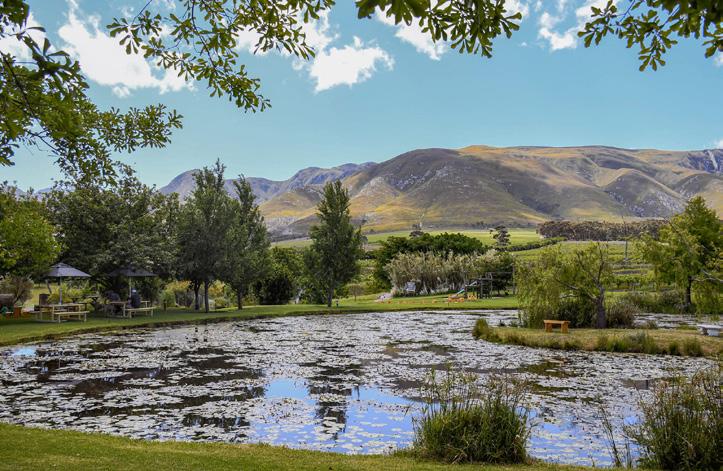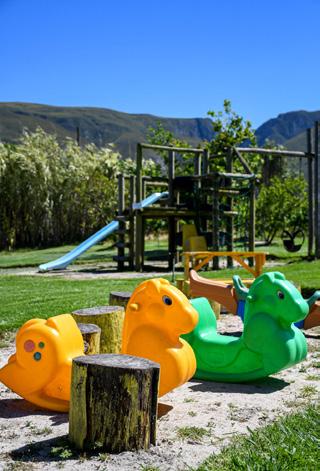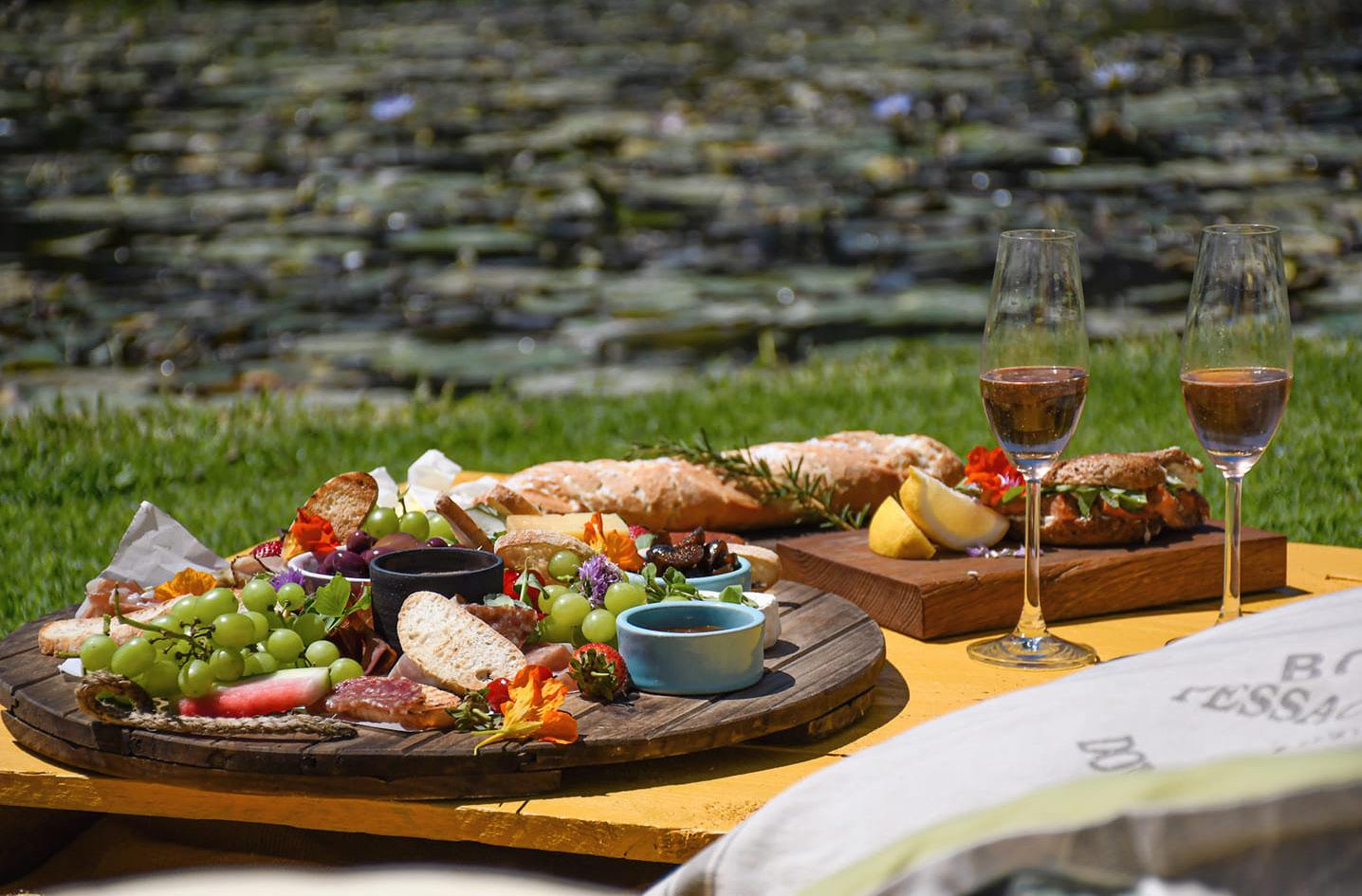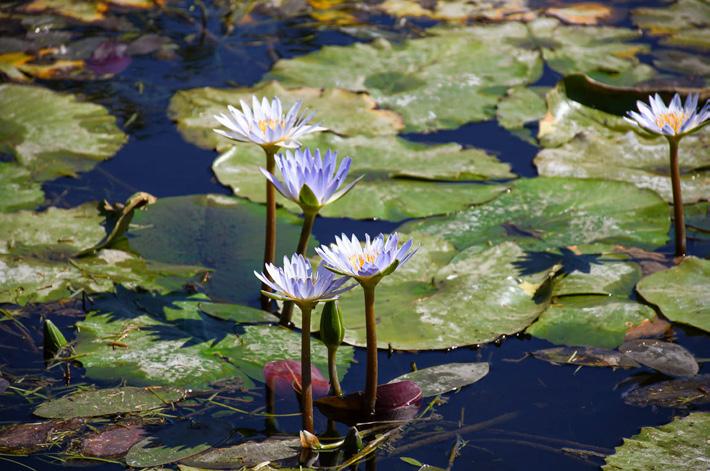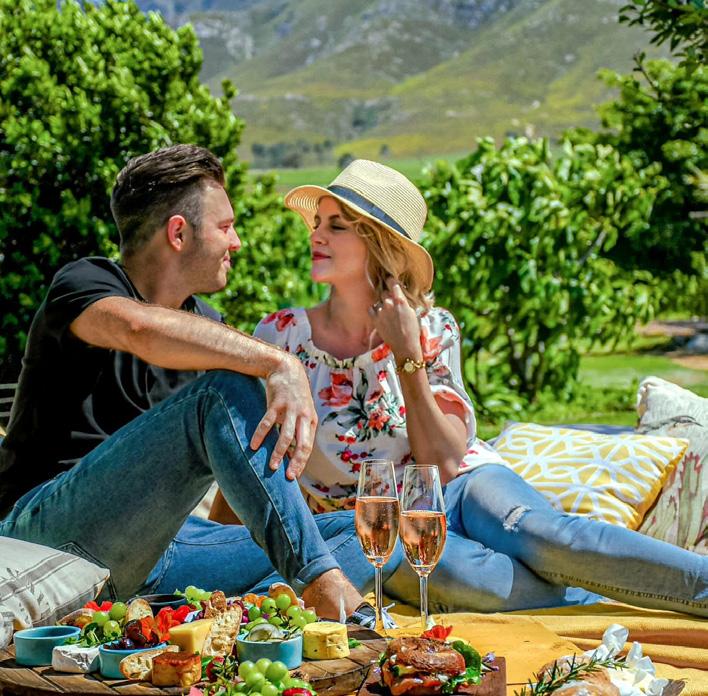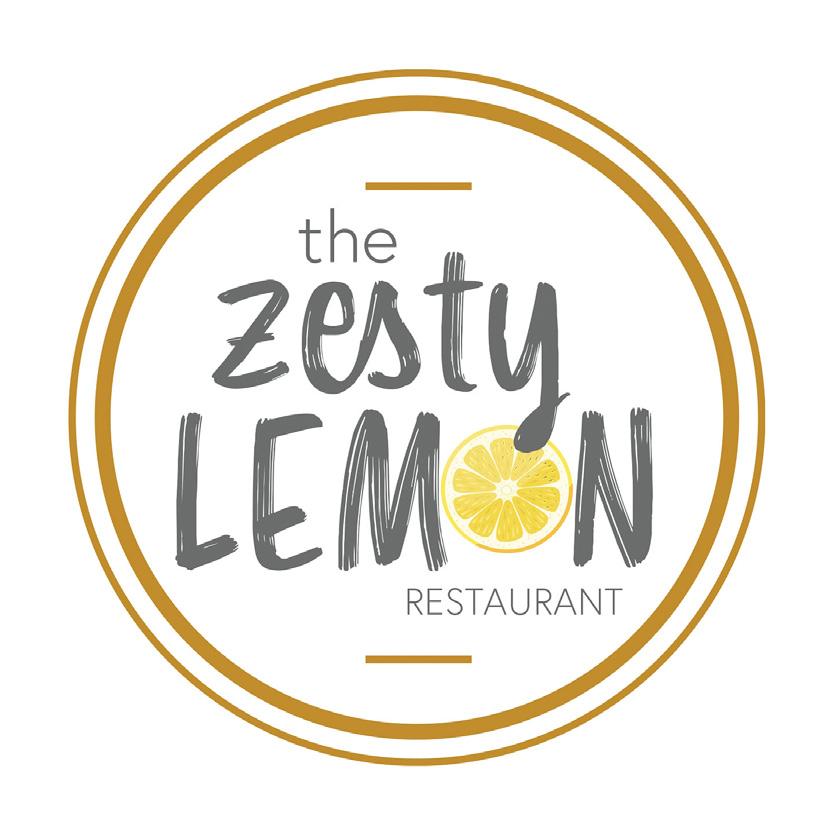people, news & what sets us apart















This month, COP27 ushered in an era of almost apocalyptic proportions. The message is clear - looking after the planet is no longer a whimsical wish but a do or die warning to humanity. In this issue, we learn about Bob, the green turtle’s jour ney of survival on page 3, a small whisper in this narrative, and Heather Robertson’s “Last Word” feature on page 19 reiterates the same sobering message.
On a lighter note, there’s a festive buzz in the air - perhaps even more so than in the past couple of years. Our village, with its new Saturday market has brought enor mous new life and energy to Queen Victoria Street, and there are more and more visitors curious to see what we have on offer.
It’s the different things that are upping the ante. Just a few that I can think of off the top of my head, fresh plants and flowers on a Saturday, traditional Dutch cooking from the heart of Amsterdam and wonderful foodie offerings from our local chefs and bakers.
If it’s preloved furniture or arts and crafts you’re after - it’s all here. Yes, this holiday season is going to be the best - you can feel it in the air.
Ready for lift-off? Well, we certainly are! Till next time, stay environmentally-friendly and enjoy the start of the festive season!
Virtually yours,
LIZ CLARKE
Publishing Editor
Articles | Photography | Reporting 060 627 9644
liz@stanfordnewsagency.co.za
MELISSA MC ALPINE
Communications Director
Advertising | Marketing | Social Media 078 324 5692 melissa@stanfordnewsagency.co.za www.stanfordnewsagency.co.za
LizThe Stanford Spectator is proudly brought to you by the Stanford News Agency

Disclaimer: Great care has been taken in the preparation of this publication. However, Stanford News Agency cannot accept responsibility for any errors which may inadvertently have occurred. The opinions expressed herein are those of the authors and/or persons interviewed, and do not necessarily reflect the views and values of Stanford News Agency. Any comments, suggestions or complaints may be forwarded to liz@stanfordnewsagency.co.za or melissa@stanfordnewsagency.co.za.
The Stanford Spectator is a bi-monthly online publication that comes out on the 1st and 3rd Friday of every month.
Advertisements to reach us by no later than the Friday before the next issue is due to be released.


To place an advertisement, please contact: Melissa Mc Alpine – 078 324 5692 / melissa@stanfordnewsagency.co.za

The 2022 United Nations Climate Change Conference, more commonly referred to as the Conference of the Parties of the UNFCCC, or COP27, comes to an end this week in Sharm El Sheikh, Egypt, with the health of oceans high on the priority list.
The ocean is a fundamental part of the climate system and the global response to climate change. Globally, the ocean covers 71% of the surface of our blue planet. It has long taken the brunt of the impact of human-made global heating. It has absorbed about 90% of the heat generated by rising greenhouse gas emissions trapped in the Earth’s system and taken in about 25% of carbon emissions, causing devastating impacts and increasing risks on ocean and coastal life and coastal communities’ lives and livelihoods.
In 2014, Bob, the green turtle was found washed up on the rocks near the De Hoop Na ture Reserve. He was disorientated and barely alive. Had he not been discovered on that day, he would have died a painful and unnecessary death – unrecorded, unnoticed.
But, luckily for Bob, there were those who saw his plight, rescued him and within a day he was at the Two Oceans Aquarium in Cape Town being cared for by the Aquarium’s turtle rehabilitation team.
Upon examination, wounds on the underside of his shell — his plastron — were found to be infected, resulting in a blood disorder and meningitis. Bob was blind and suffered brain damage.
“We knew that getting him back up and going again was going to be no easy task,” said Alex andra Panagiotou, one of the team members. “But, our commitment was to give him the best chance we could for recovery.”
Three months after the green turtle’s arrival he pooped out a load of plastic, including plastic packets and part of a balloon with the string still attached, foreign toxic objects, that left untreat ed, would have led to his death.
Above: Bob the green turtle.
Below: De Hoop Nature Reserve.
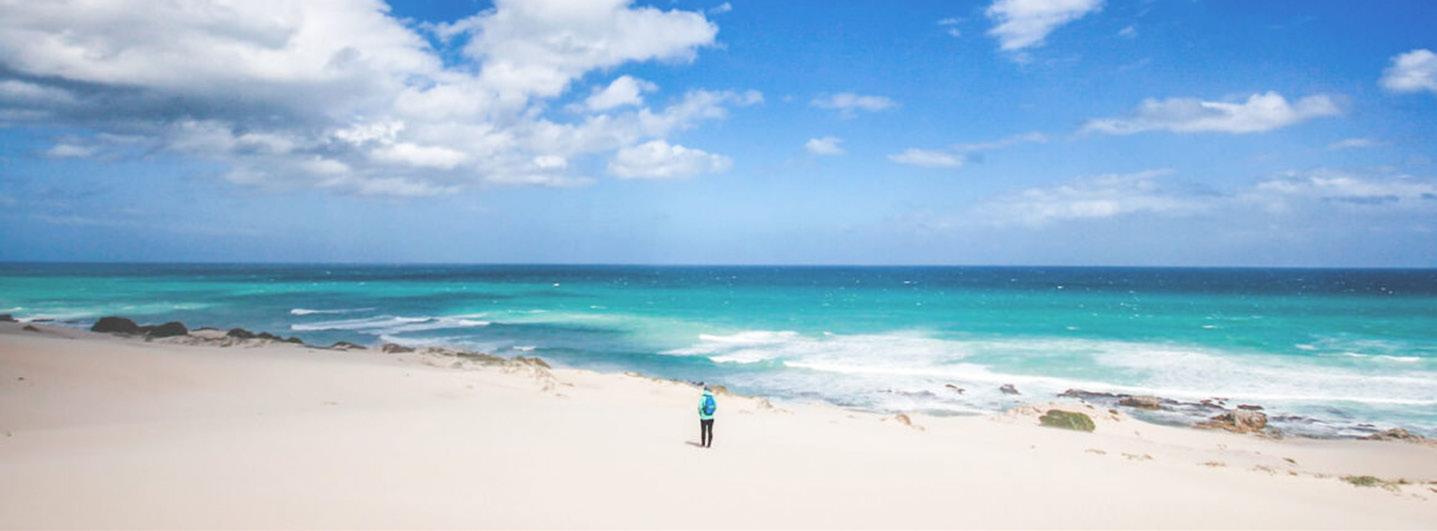
Green turtles are so named because the fat layer underneath the carapace (shell) is green. The external colour of these turtles’ ranges from a very dark brown to a light brown mottled colour.
Green turtles and loggerhead turtles cannot be reliably distinguished from one another just by looking at their colour. Rather, they can be distinguished from each other by looking at the general body shape (greens are rounder with a flatter lateral profile and a much smoother shell), the shape of the bill (hooked in loggerheads, but not in greens) and, most importantly, the number and arrangements of the central carapace plates and lateral plate rows (5 lateral plates next to central row in loggerheads, and 4 lateral plates in greens).
Adult green turtles feed mainly on seaweed and seagrass and therefore can often be seen close inshore, basking at the surface.
Female green turtles can lay up to 150 eggs every 12 days or so, totaling around 600 eggs per season. Nesting occurs on the islands off Mozambique and on other Indian Ocean islands.
On some of these islands, green turtles have been hunted almost to the point of extinction.
Green turtles are found worldwide primarily in subtropical and temperate regions of the Atlantic, Pacific, and Indian Oceans, and in the Mediterranean Sea.

“Slowly over time with correct the medication and care, Bob started to heal,” says Talitha Noble, the Conservation Coordinator and head of the turtle rehabilitation programme. “He is such an incredible turtle — he is just a little bit of extra work, like a special needs kid.”
Noble’s commitment to turtles damaged by plastic pollution is to take on marathon swims to raise money for awareness, treatment and healing.
“I love swimming for a great cause, and this is certainly one of them” she says. Bob’s eyesight has recovered, and he now behaves normally, reports the team. Their biggest concern now, is how brain damage could affect his release.”
The current rehabilitation regime includes dummy runs with Bob to see how well he copes with foraging and diving in natural surround ings. If all goes to plan, it means he could soon be sent home - to the sea, to travel and live out his natural life.
“It will be a triumph for Bob,” says Noble “But, saying goodbye to a creature that has overcome so many challenges and taught us so much will be very tough.”
We will wish him Godspeed ... our brave ocean warrior, with a clear message for every one ... keep our oceans plastic-free!
Bob arrived on the 6th of November 2014 as an injured sub-adult green turtle (Chelonia mydas) and was delivered into the hands of the Two Oceans Aquarium team weighing just 16.6kg (in contrast to his now 85.6kg). He was rescued by Lieze Swart of Oceans and Coasts and transport ed through to Cape Town by Darrell Anders from the Department of Forestry.
melissa@stanfordnewsagency.co.za
NOVEMBER
23 Connect to Your Calm (10am – 1pm)
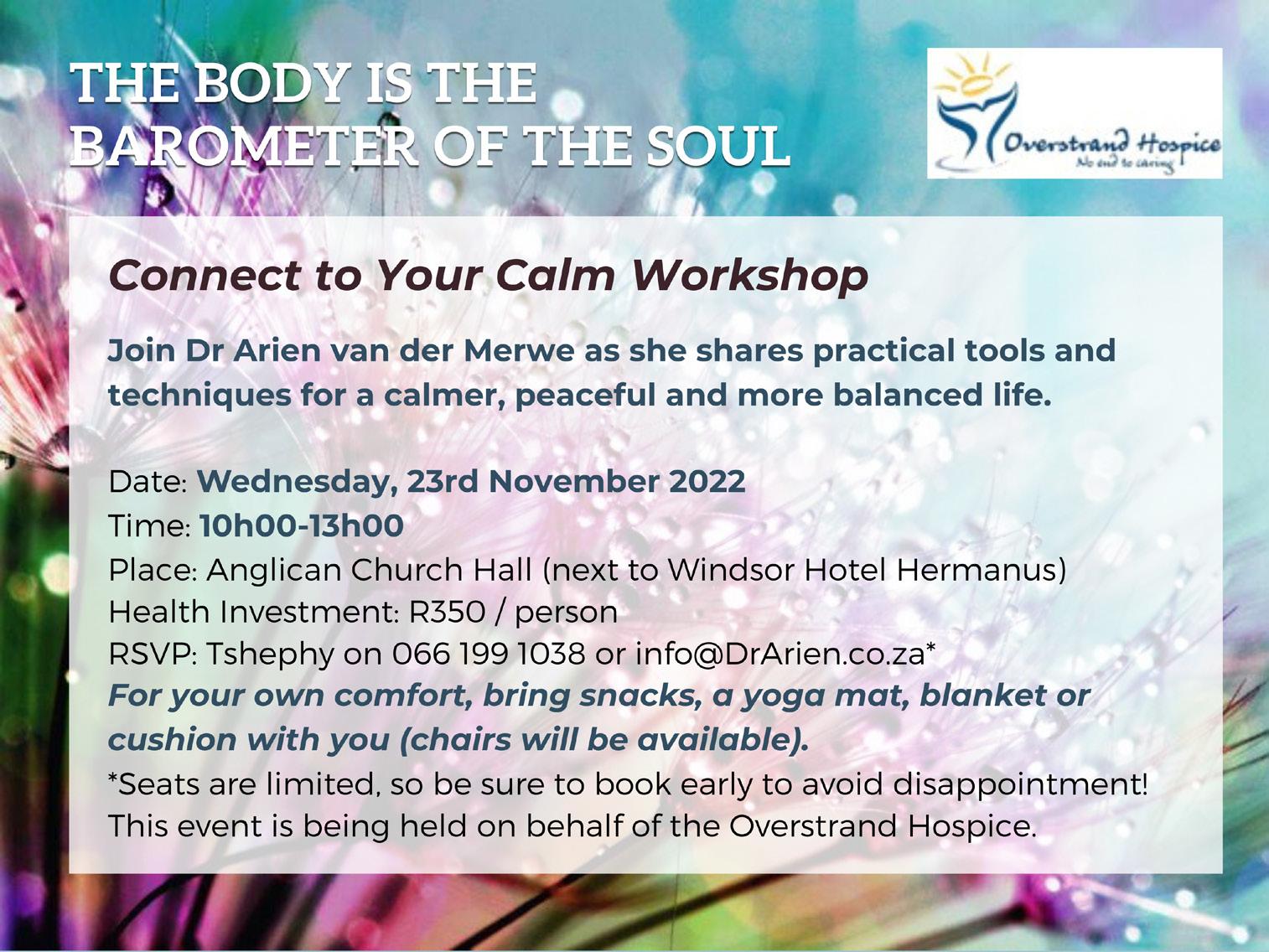
Health Investment: R350
Anglican Church Hall, Main Rd, Hermanus
27 Overberg Toy Run (Gansbaai to Stanford)
Bikers will gather at 4 points over the Overberg and will join to form a mass ride, ending up in Stanford.
Wimpy, Great White Junction, Main Rd, Gansbaai
Phone: 083 261 5675
E-mail: info@overbergtoyrun.co.za

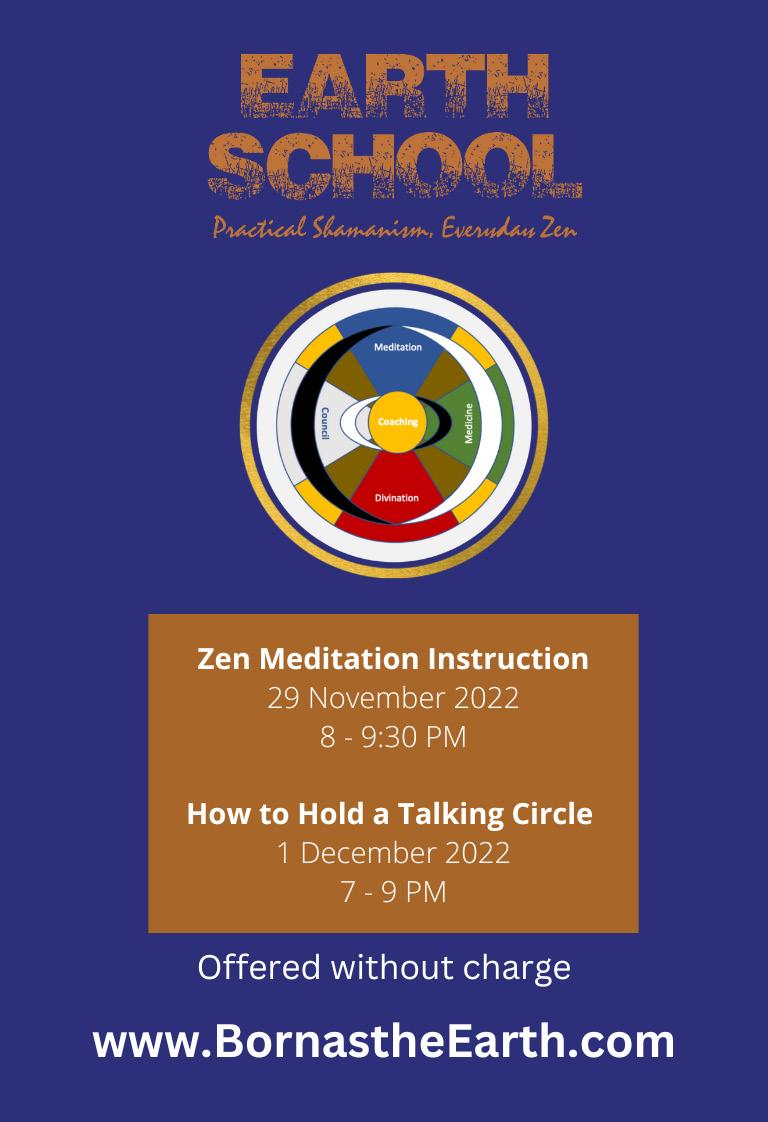
29 Zen Meditation Instruction (8pm –9.30pm)
For further info, visit: www.bornastheearth.com
DECEMBER
1 How to Hold a Talking Circle (7pm –9pm)
For further info, visit: www.bornastheearth.com
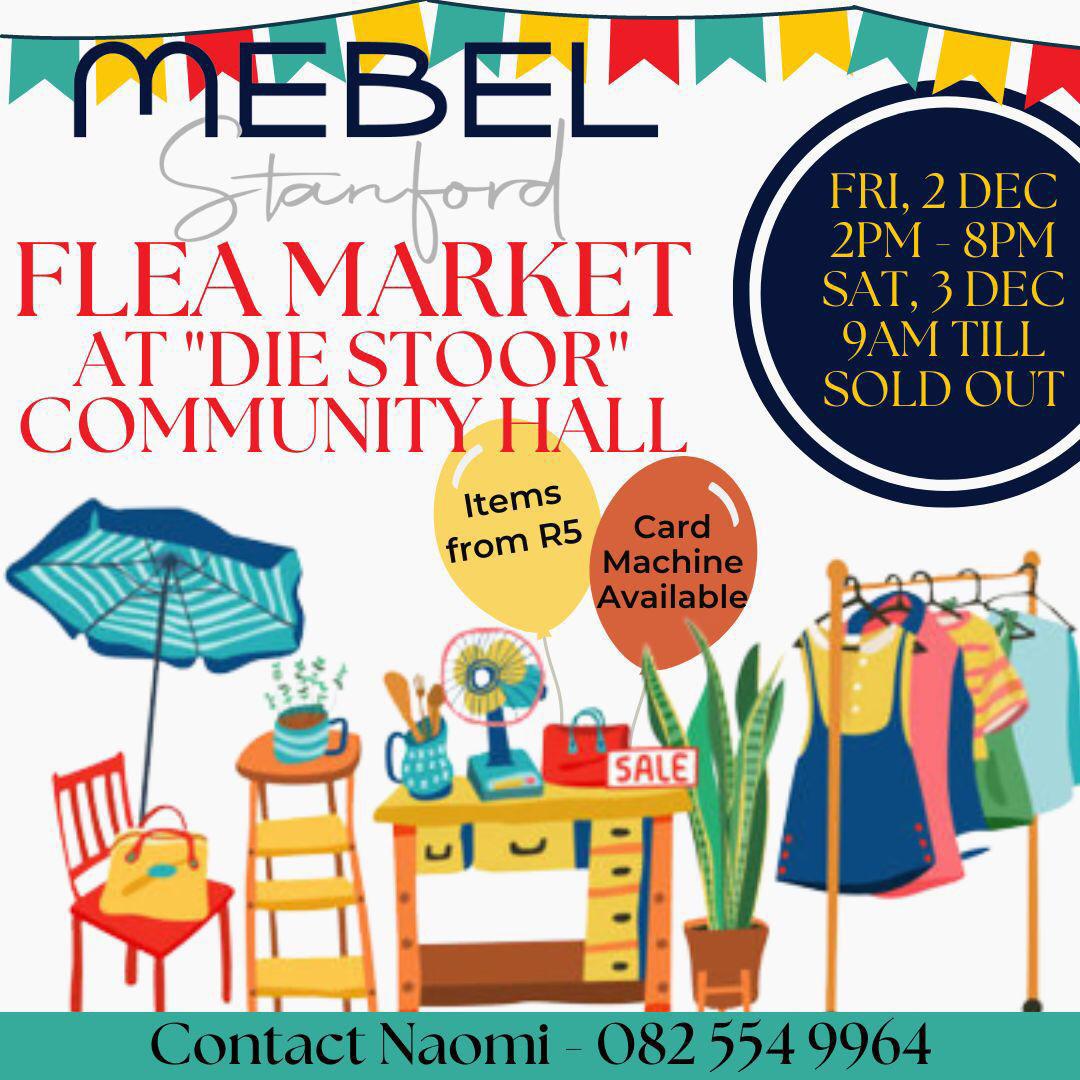

2 Mebel Flea Market (2pm – 8pm)
(“Die Stoor” Community Hall, Stanford)
3 Mebel Flea Market (9am until all sold out)
(“Die Stoor” Community Hall, Stanford)


Every Monday
Painting Classes with Tracy Algar R200 Egret & The Owl Book Café
Every Saturday
Stanford Square Market (9am – 2pm)
Stanford Square (Centre of town)
Details: Kathryn 083 677 5737
Stanford Saturday Morning Market (9am – 12pm)
Stanford Hotel Stoep
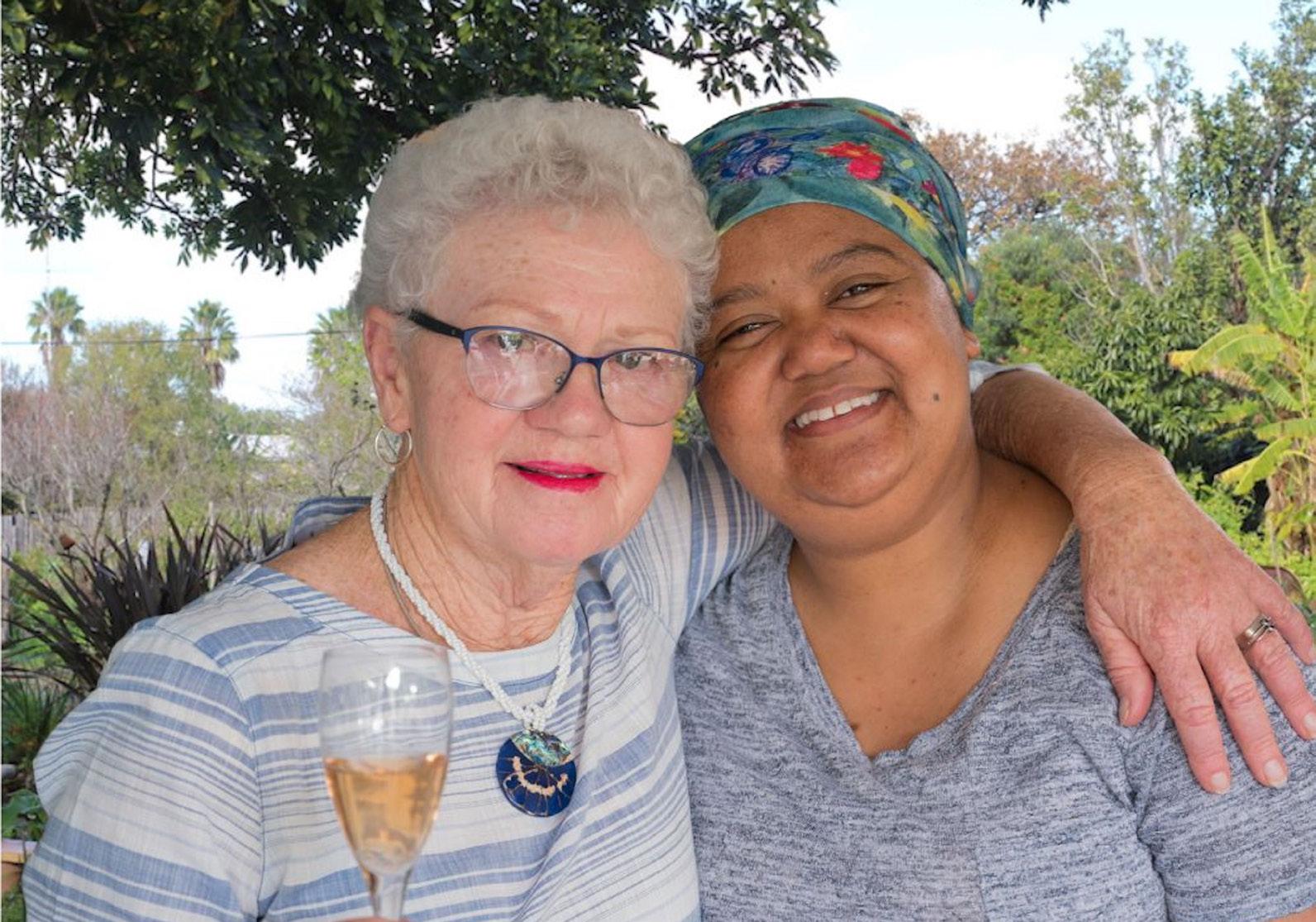
Last month, Stanford South’s Jacoline Louw (remember her picture – on the cover of Issue 02 of the Stanford Spectator?), wowed visitors and locals alike with her skills as a chef showing off her talents to great ad vantage during the UNESCO Stanford Culinary Experience.
It wasn’t long before word got around that her lunchtime menu of curried tripe (offal) done with a secret recipe of spices, herbs and sauces, chocolate and coconut coated laming tons savoured with home-made ginger beer done the traditional way was not to be missed.
Interviewed before the event, Jacoline said that her biggest wish was to start her own catering business and to encourage others in her community to share their skills. She hoped that the Culinary Experience might be the starting point.
“I’ve always loved cooking – even as a child – thinking up my own recipes and then testing them out on my family and friends. I thought that maybe one day I can do this for real.”
Earlier this month, her fledgling catering business took another step forward when she was invited to cater for a special birth day gathering at a private home in Stanford Village, tempting the guests with a wide variety of cocktail snacks – everything from sesame covered chicken wings in a tangy, sticky sauce to spicy tartlets and her own secret recipe style of samoosas.
“I was really nervous,” she admits. “I had never done anything quite like this before. I was hoping and praying that people would like what I did.”
She needn’t have worried. The guests loved it – even asking her for her recipes.
“After this I will have a lot more confidence. There are so many recipes that I have collected, many of them handed down from my family over generations. Being able to share them for the first time in this way has been such a privilege.”
If there is one iconic delicacy that Jacoline never leaves out, it’s her lamingtons – light as feather sponge fingers with coconut and hints of homemade jam topped with cream and strawberries.
“My gran taught me to make them when I was six years old. They aren’t so easy to get right – but believe me, I have had plenty of practice!”
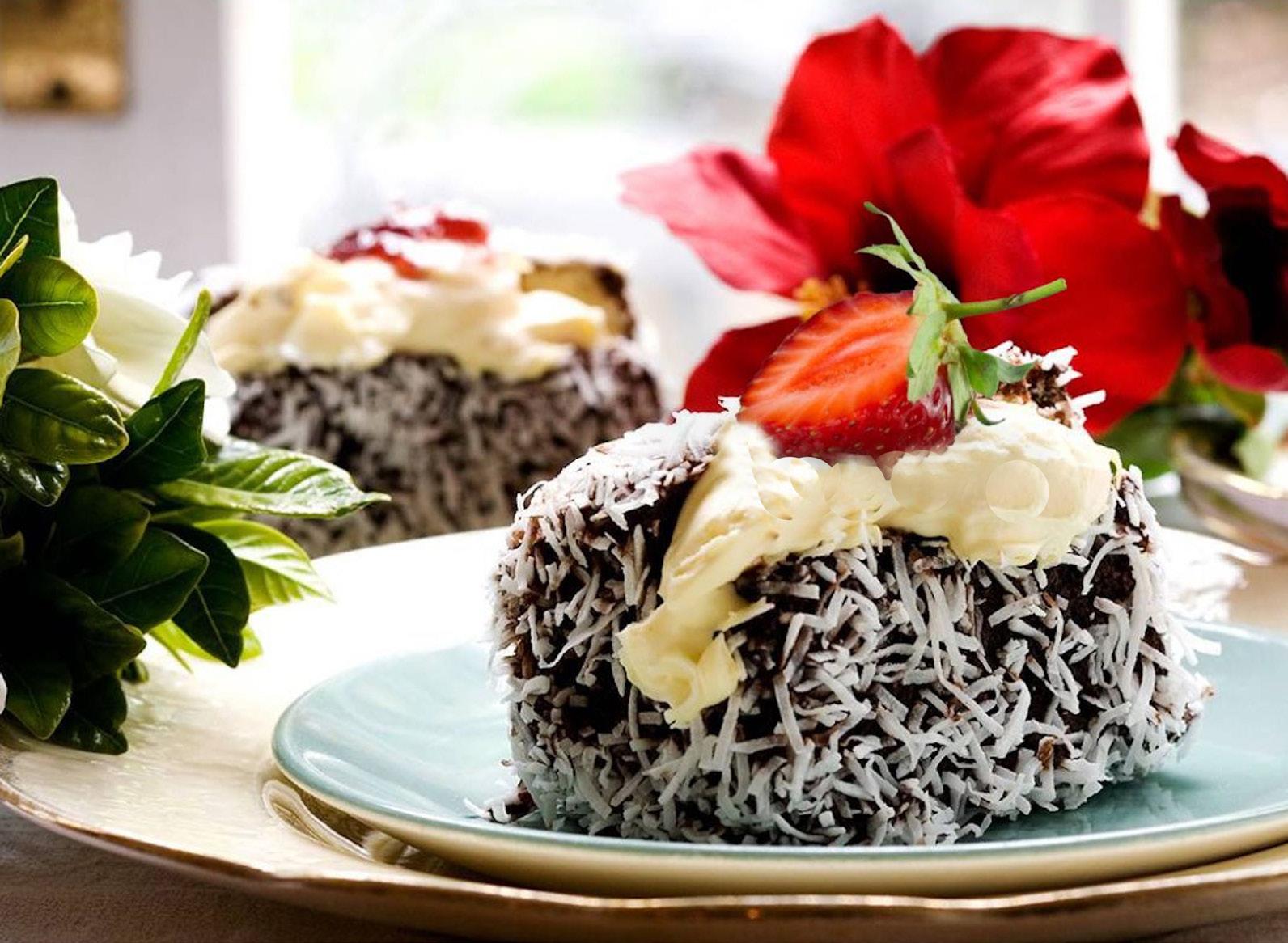
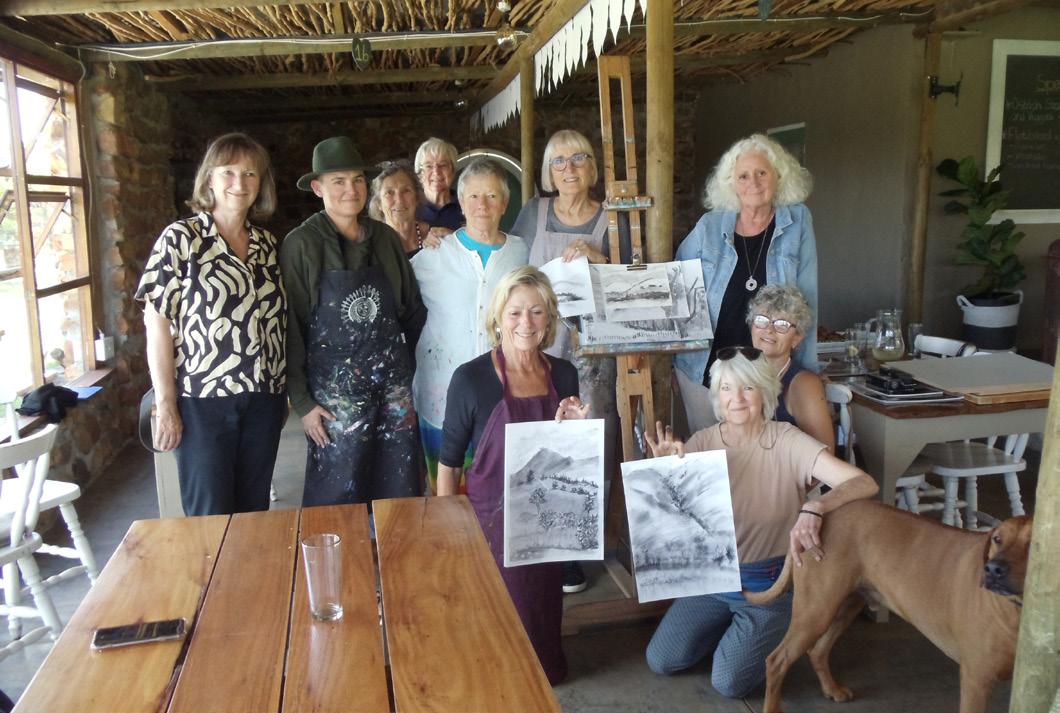


On Wednesday, the 26th of October, a group of eight artists and budding artists got together for a morning of learning to work with Charcoal. Most of the group had never tried this medium before, so it was a learning-while-having-fun experience. There was much concentration, admiration of each other’s works in progress and laughter. The workshop was a Stanford Rotary fundraising ini tiative. Rotary would like to thank Sandy and Marlene for putting the workshop together, Tracy Algar for teaching and demonstrating, Stan ford Hills for the venue, Annie for the cupcakes, and most importantly to all the ladies who joined in and took part. By popular demand, this type of event will definitely be repeated in the new year.
Early in November we received a request from Kevin Husk at the CPF for soccer balls for two Stanford soccer teams – the Young Tigers Juniors and a team from Die Kop. Sport is so important for the devel opment of our youngsters, so of course we obliged. There were many happy smiles from both teams.
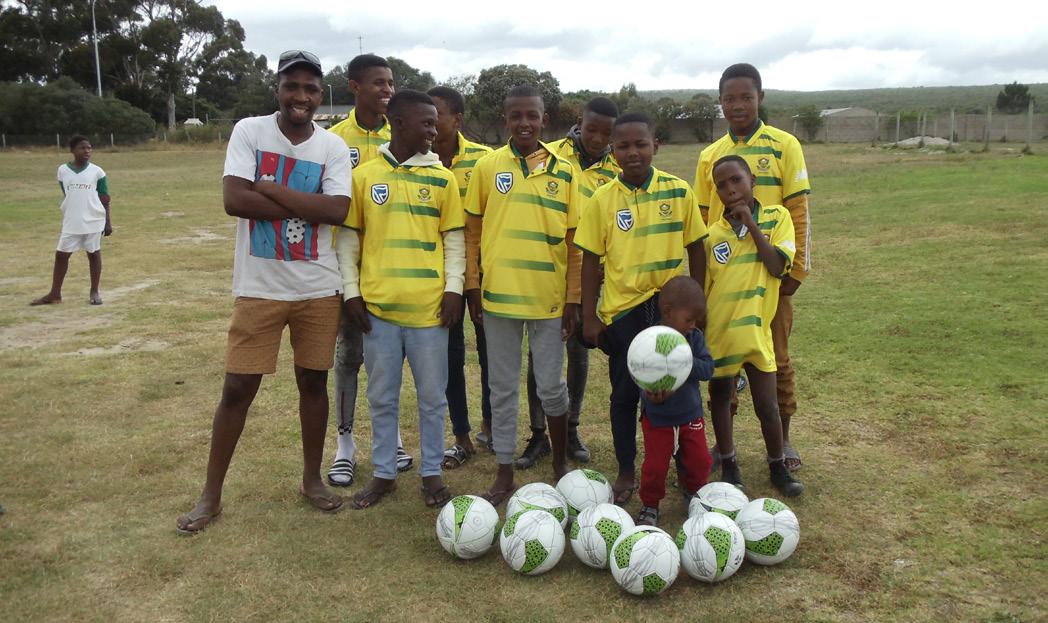
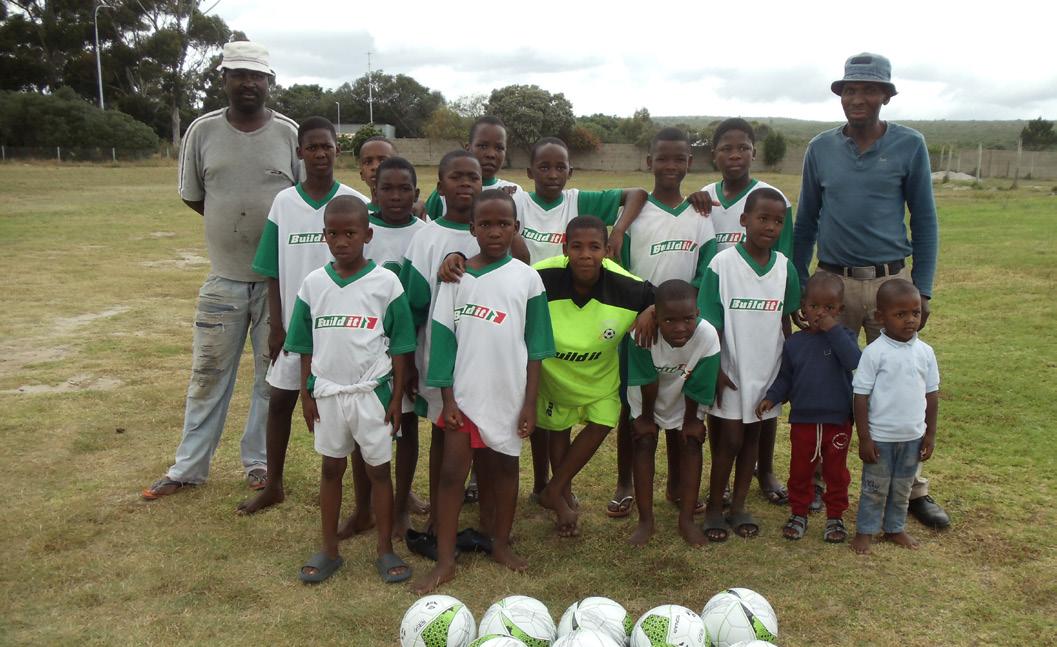
We have a dedicated fund for Sports Development, so if you’d like to support this initiative please feel free to contact us.
Below
Below
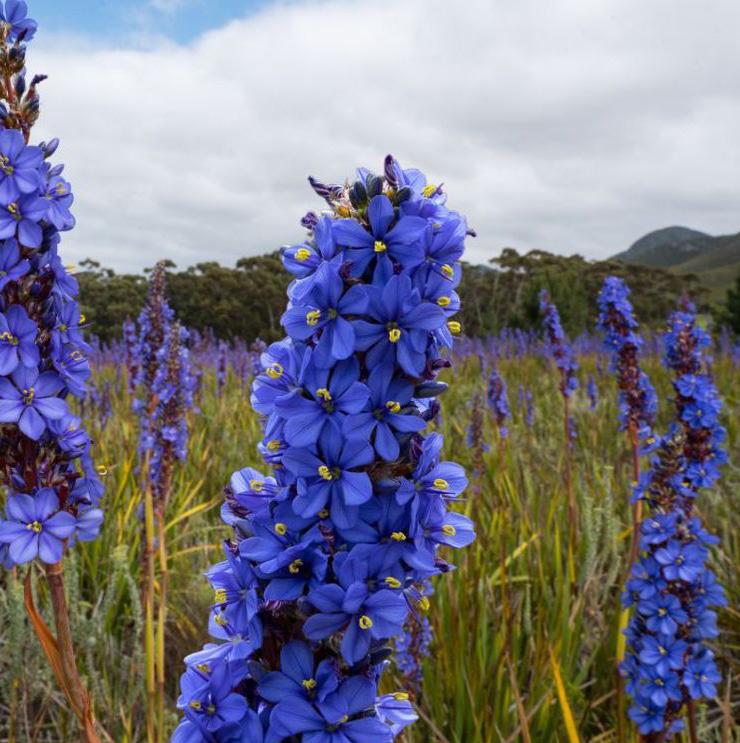
Imagine embarking on a brisk walk to Cape Town starting at the Stanford Circle. The distance covered would be 144 kilometres. That’s one and a half Comrades’ Marathons.
Granted, the Stanford Striders don’t do it all in one go. Nevertheless, in their striding season that’s the distance they travel. Multiply that by 11 – being the number of years this same group has been doing their fast-walking thing, they would have travelled 1 584 kms –that’s the distance from the Stanford Circle to Pretoria and out the other side.
Andrew Herriot, founding member of strid ers, and one who likes to walk fast, even at
home, says that in the beginning their walking group used to be run on a time trial basis, competing for the first over the line – and in record time.

“It was enormous fun and hugely challeng ing” says Andrew. “But then when we all got a bit older, we lost the competitive edge and decided that just walking briskly, striding out and being healthy is what we needed.”
Not that they’ve slowed down, adds Andrew. “We are more walkers with a purpose.”
Unfailingly this smallish group of devoted striders sets out on a Monday at 5pm sharp and can be seen chattering their way through

Stanford’s streets with their faithful hounds weaving between them. On the final Monday of each month, the stalwarts doggedly stride their way through the Stanford Hills vineyards looking forward to a congenial supper.
“And don’t forget the wee glass of some thing” says Andrew. “We earn it after all that exercise. That was a ritual even during the dreadful masked days.”
While many of the 2011 Striders have moved on, there’s always new replacements of equally enthusiastic fitness fanatics.
“The concept stays the same,” says Andrew. “Keep on striding in Stanford!”
Tourism in the Western Cape could fully recover this festive season if traveler forecasts are on the mark, reports News24. The industry has been hard hit by two years of travel restric tions due to the Covid-19 pandemic.
During a presentation to the Western Cape Standing Committee on Finance, Economic Op portunities and Tourism, Wesgro CEO Wrenelle Stander said traveler forecasts showed a strong chance of recovery in November and December, with January expected to bring growth to the tourism industry.
Wesgro is the official tourism, trade and investment promotion agency for Cape Town and the Western Cape.

Read more: https://www.news24.com/ news24/southafrica/news/western-cape-tour ism-poised-for-recovery-but-jet-fuel-concernsremain-20221109

Hailed as a breakthrough, South Africa is expected to begin piloting the every-oth er-month HIV prevention shot early next year, according to the international medicine financing initiative Unitaid. The injection could prevent as many as 52 000 new HIV infections in the next two decades if rolled out nationally, but the big question will be about pricing.
Read more: https://nationalinterest. org/blog/coronavirus/miracle-shot-newbooster-could-save-90000-lives-win ter-205260
The DA will write to the trustees of the Het Jan Marais Fonds requesting them to consider defunding Stellenbosch University (SU) unless the university management explicitly rejects the recommendations of the Khampepe report on the extinction of Afrikaans at the university.
Read more: https://www.da.org. za/2022/11/da-calls-on-het-jan-maraisfonds-to-consider-defunding-stellen bosch-university
Suspended public protector Busisiwe Mkhwebane has been living rent-free within the luxurious Bryntirion Estate, which includes lavish residences for the President and cabinet ministers, since February 2017.
Read more: https://www.da.org. za/2022/11/disgraced-public-protectormust-pay-her-fringe-benefits-tax
Most of the organisations that made presentations to the parliamentary portfolio committee on basic education regarding the Basic Education Laws Amendment (BELA) Bill, have seconded the DA’s concerns – particularly the problematic ‘Lesufi clauses’ which seek to remove school governing bodies’ (SGBs) powers to determine the ad mission and language policies of their schools.
Read more: https://www.politicsweb. co.za/politics/opposition-to-draconi an-bela-bill-continues--bax-n
While Ineke’s Dutch accent tells you that her roots are far removed from Stanford, the vibe she is creating at her newly acquired Union Café tells you that ‘home’ is right here.
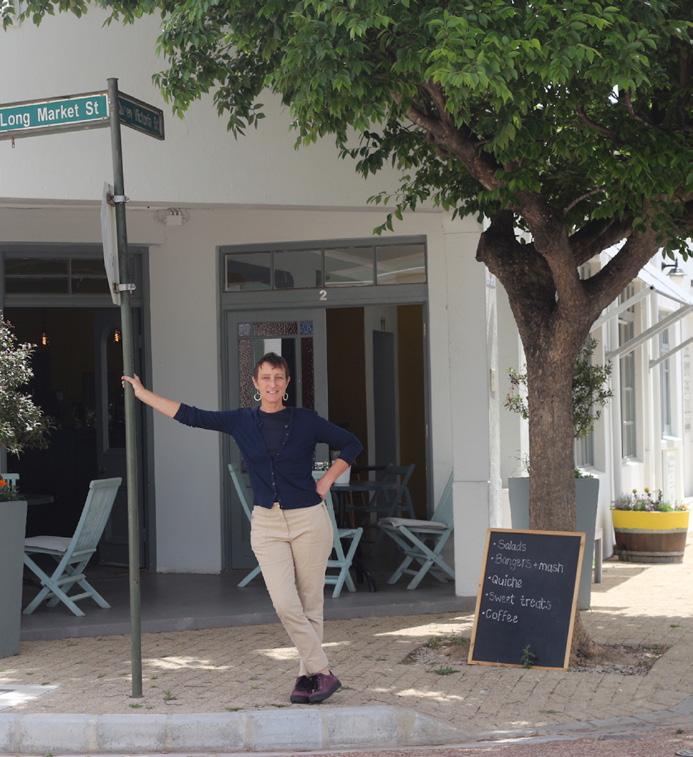
“I love this community and the whole atmo sphere of people looking out for each other,” she says.
Her customers range from regulars to outof-town visitors.
Each day, food is freshly prepared from scratch and the menu includes meals ranging from light snacks to wholesome meals. Union is an eatery that considers food a vital part of one’s health and wellbeing.
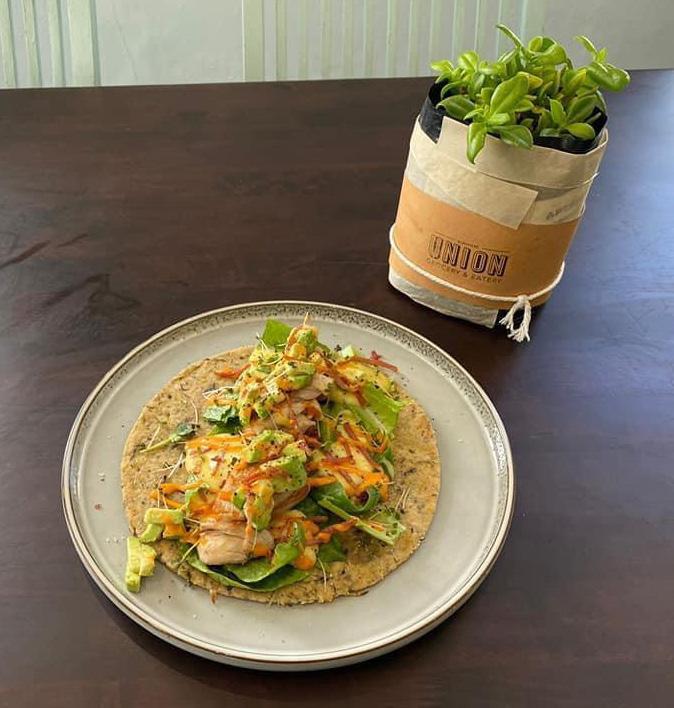
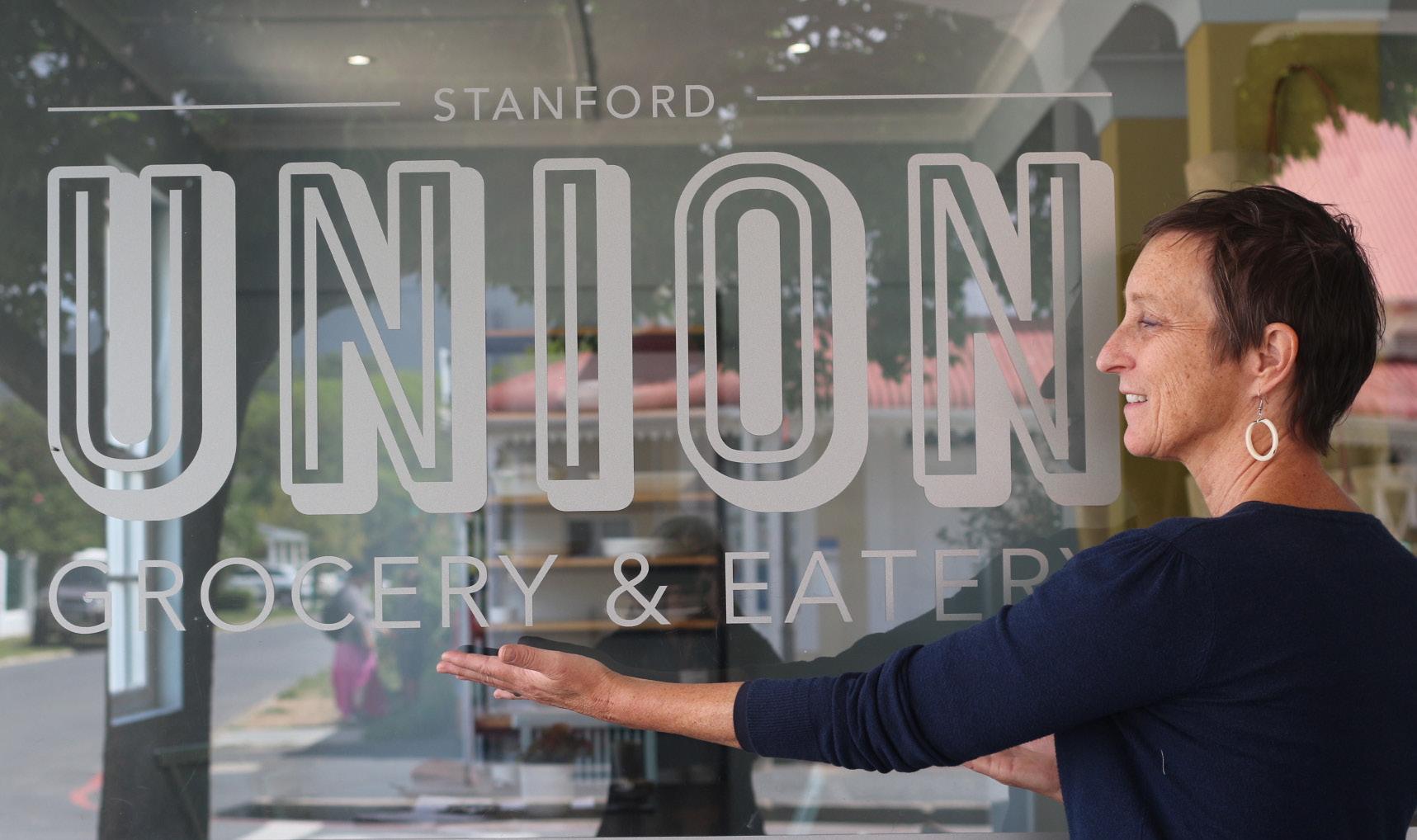
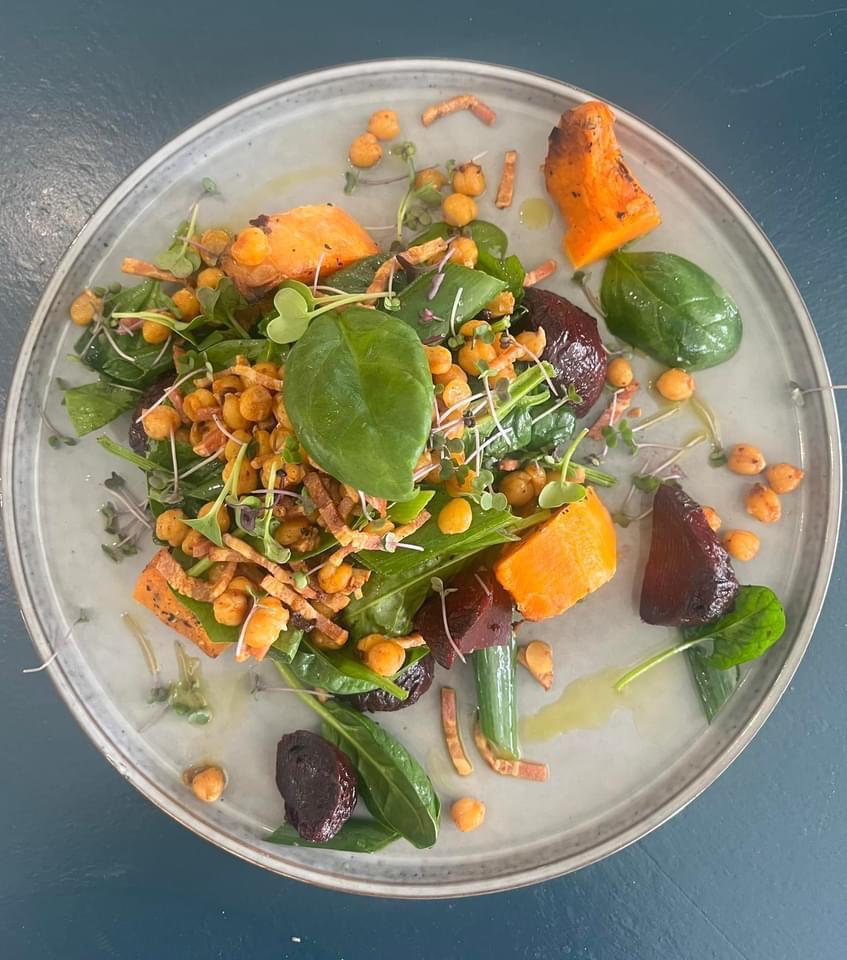
“It’s important to think about your footprint, what you eat, and where your food is sourced from” says Ineke. “I need to know where all our ingredients come from, how they’re produced.”
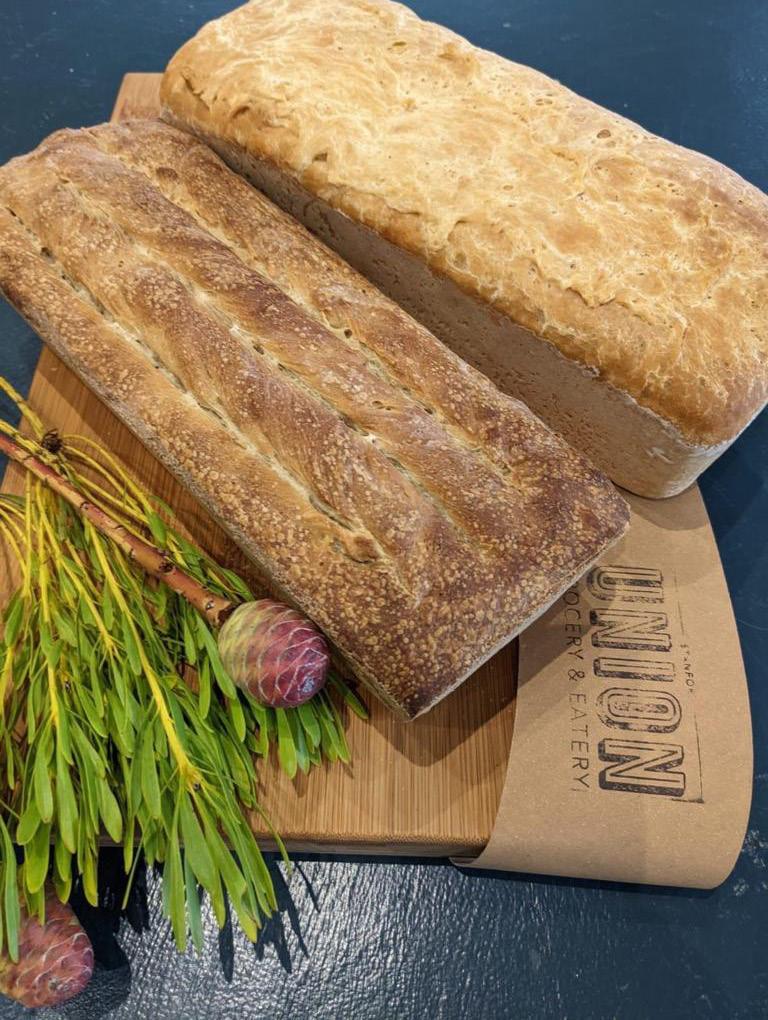
And let us not forget the special loquat relish made from fruit picked from Ineke’s own garden. This unique chutney is served with Omelettes for breakfast. Bread is baked every day on the premises and includes sour dough bread, farm loaf, gluten-free bread, as well as rye bread.
Asked what brings customers back, Ineke smiles and says “People come back for the coffee! Our chocolate cake, orange cake, and home-baked apple pie are favourites too.”
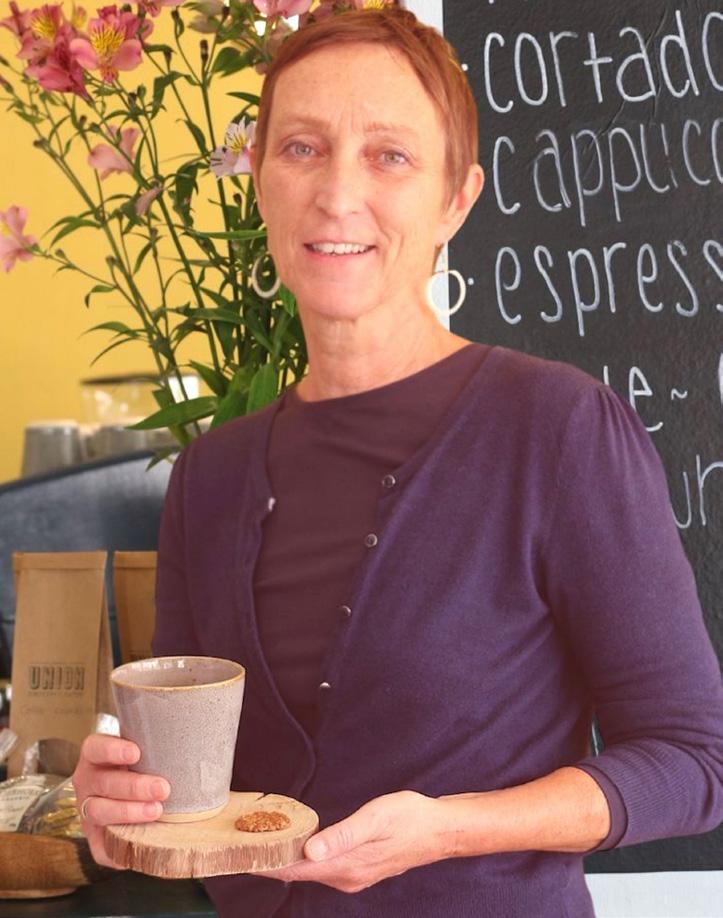
Union is fully operational during loadshedding times since a generator is available so people can enjoy free WiFi.
The deli section is well-stocked with organic products such as olive oil, jams, gluten-free biscuits, and baking ingredients, stroopwafels, and Eggcellent Eggs – all sourced locally.
When in season, fresh fynbos flowers are also available.
At Union there is something for everyone.
Started by Angus and Jess Nel during the Covid lockdown, Calories Food Truck (open daily) has become the favourite ‘goto’ place for tasty and good quality fast food in Stanford. All meals served have been inspired by local customers and can be defined as simple, honest, home-cooked food.
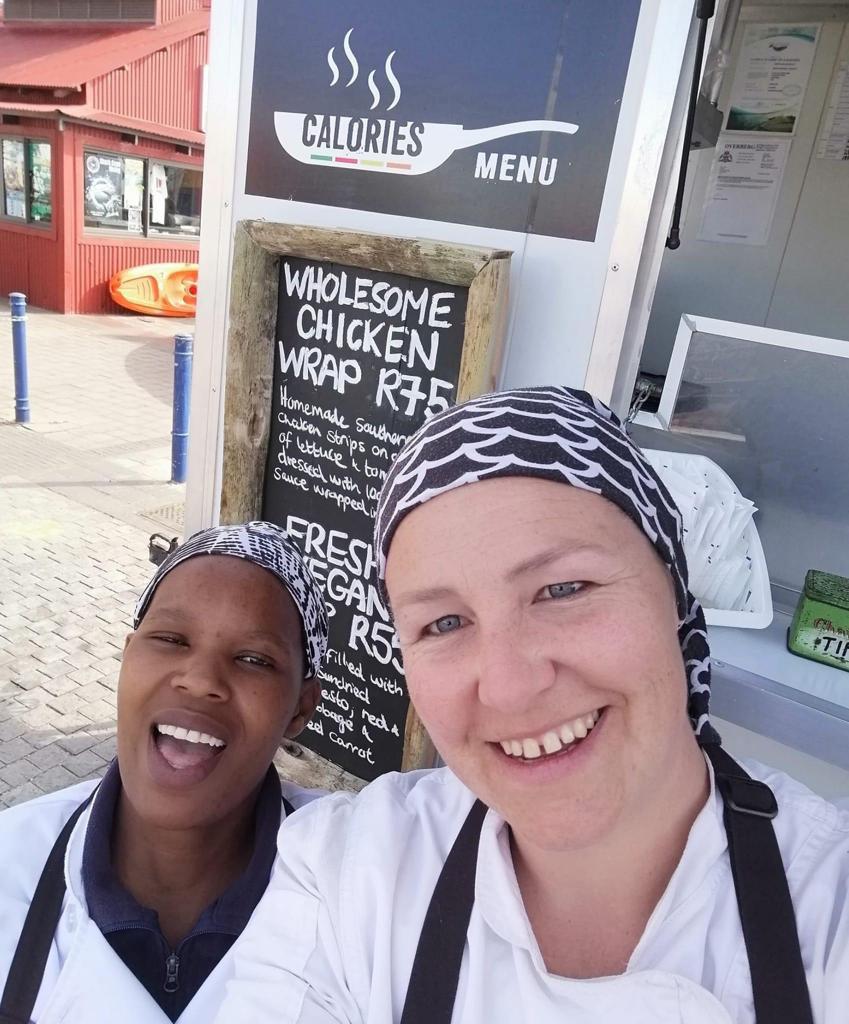
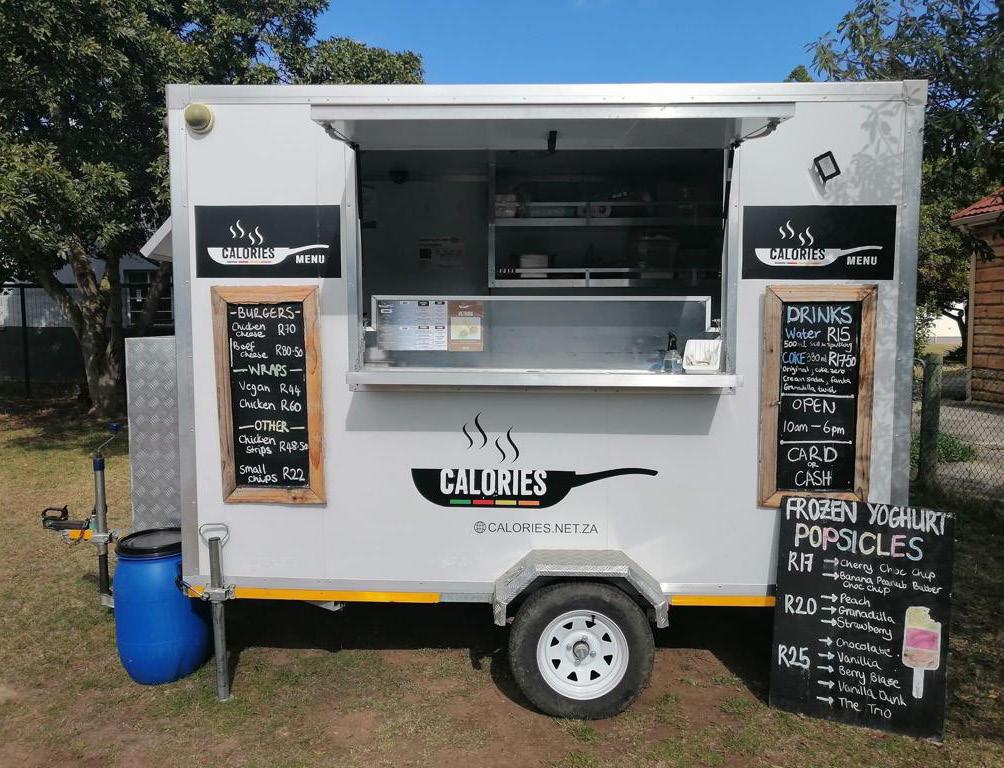
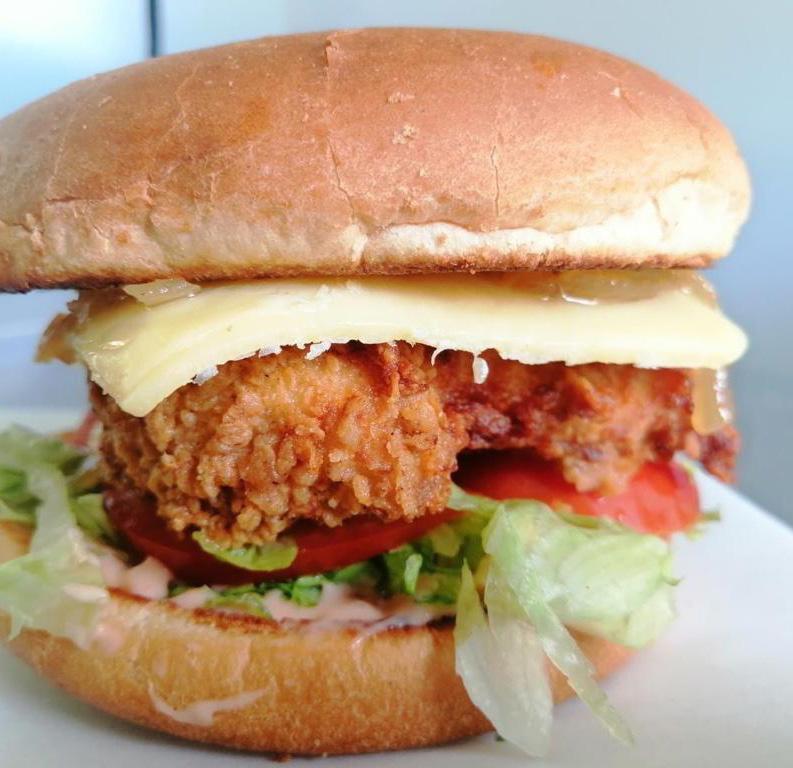
As Jess says, “I will not serve anything that I myself wouldn’t eat or serve to my kids.” Their food truck is custom-built, family-owned
and completely off-the-grid as it runs on solar panels and gas. The menu consists of hot chips, healthy wraps, burgers and famous chicken strips (marinated overnight, coated in seven secret spices and crisped to perfection).
It’s a place where getting your food is as easy as pie. You can either order your meal right there, or if you don’t want to wait, you can place your order via WhatsApp and then collect your meal on the way home. An ideal solution for busy people on the go, Calories also sells cook-from-frozen items such as
chicken strips and waffles. Their all-natural, guilt-free frozen yoghurt popsicles have become a firm favourite with locals too, espe cially for kids looking for a cool and refreshing treat after school. Since Calories Food Truck is completely mobile, they are also available to travel and cater for functions.
Stanford has its own Earth School - a school that teaches holistic regeneration of people and place through zen meditation and sha manic wisdom practices. Offering online and in-person long and short courses as well as syllabus programmes, Earth Schools’ education model is experiential and co-operative focusing on nature-based spirituality.
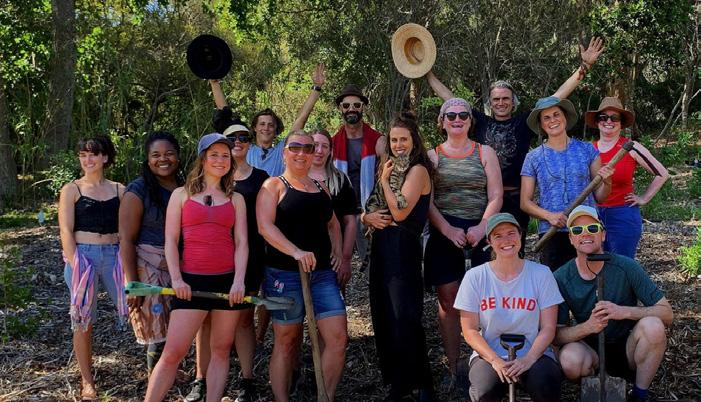
“Human sustainability on planet earth de pends of our capacity to reconnect with what sustains us, and by our actions demonstrate gratitude for the abundance life offers us ev eryday. As creative beings we can radically alter the dire direction we are heading in.”
A Rites-of-Passage School where partici pants work independently and collaboratively facilitating transformation in participants and their relationships to others and all beings. With a vision to meet a required shift in human awareness and way of life, Earth School teach es practical spirituality to create a new human story.
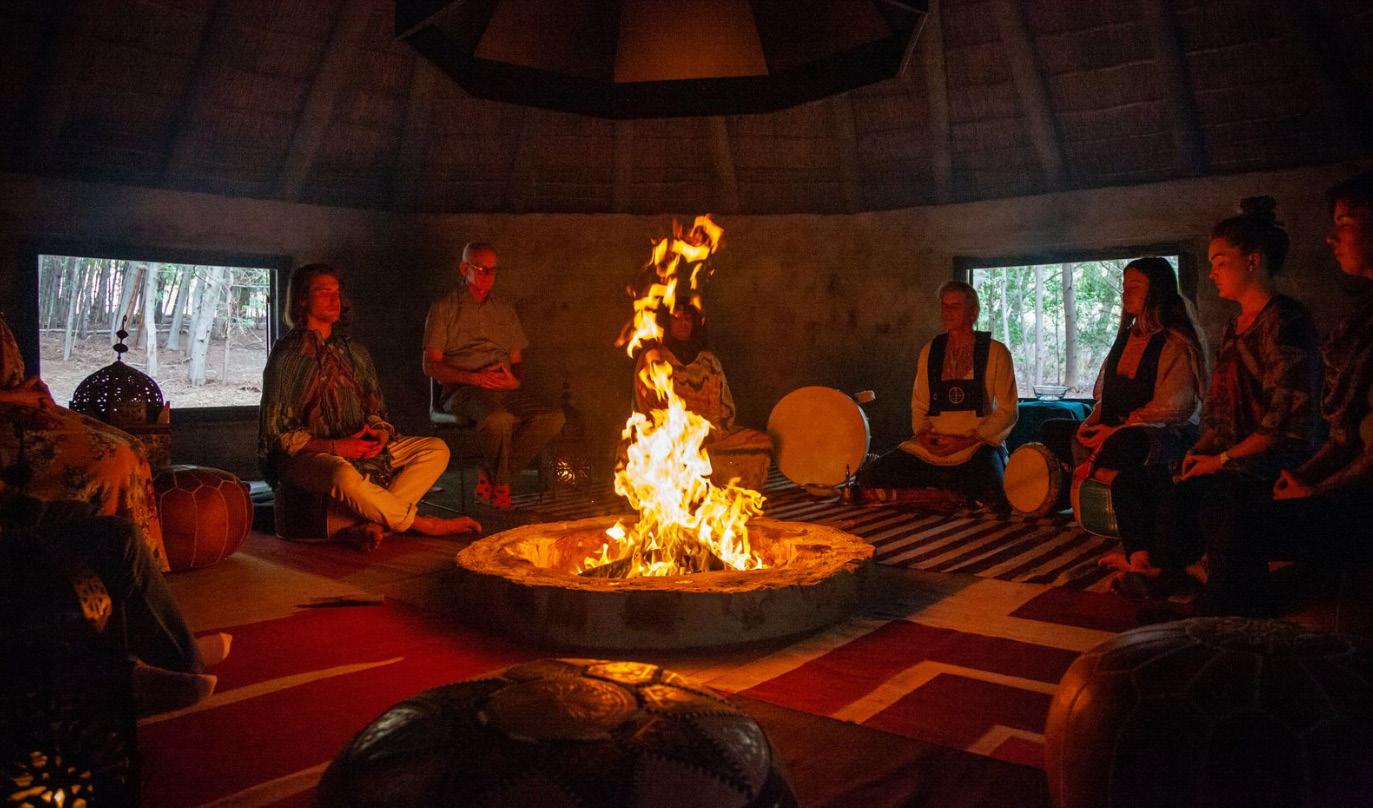
Earth School has been created to offer a reliable path for people to claim their potential and put that potential to work for the benefit of future generations and all beings.
Founder Glenn Nangaku Leisching, a Zen Buddhist priest, had life changing awakenings as a young adult realising we are the creators of our world, and have the capacity to heal ourselves and others. This took him on a quest searching wherever he could, and reading ev ery spiritual or holy book he could find. Seeking out teachers he went to the Buddhist Retreat Center in Ixopo, KZN to learn from a Buddhist monk. He then joined a ritual society where he met spiritual healer Baba Credo Mutwa and had a lasting connection with him. Glenn
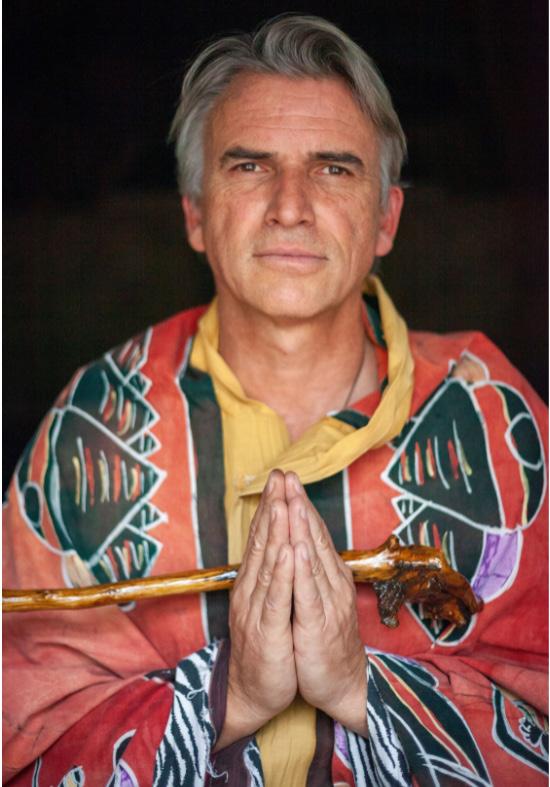
travelled through Europe, the Middle East, Africa and North America visiting sacred sights and took up residency in the U.S.A where he studied with a Zen master for 13 years. During this time he got married and had two children. While in the USA he met a West African sha man who introduced him to a powerful teacher in Burkina Faso.
“He had visited me several times in my dreams and then I met him in person and underwent initiations and became a tribal elder. I realised I was meant to merge both Zen and his shamanic lineage and create a system of learning that included both. I am guided by the mysterious wisdom of love and its power to heal. I speak for Mother Earth. I teach for the trees, waters and all beings. I have no other purpose than these.”
‘Born as the Earth’ school is a result of teach ings from diverse wisdom keepers resulting in a practical mystery school. Programmes from Earth School are accessible to everyone through mentorship coaching, divination, weekend retreats and deeper training over sev eral years. Those most suited to the teachings are those on a threshold of change with genu ine enquiry as to their purpose in this life.
Earth School uses a medicine wheel as its training matrix. The Medicine Wheel can hold and support anyone with anything they are encountering and meet them exactly where they are at to bring healing, wisdom, and wholeness. Earth School is a grounding plat form and orientation for people to claim their sovereignty and bring their ‘medicine’ or gift, into the foreground.
“Often”, explains Glenn, “people are awed at their capacity to shape their own lives and
at how responsible they are for creating their reality. All the medicine they could wish to have is right around them. People wish they had dis covered this many years ago. Earth’s elemental bodies are inside us, we have just forgotten how to function with them.”
Everything we do is informed by the intelli gence in Earth’s elemental bodies - water, fire, earth, nature and stone. The building blocks of life, their unique energies generate diversity, balancing and maintaining a complex, natural web of wholeness. Our bodies are formed from these elemental bodies. We are born as them. They are a part of every thought, tool and action. The medicine of these elemental bodies are gateways to our origination, to our present circumstances, and to our future.
“Now, more than ever, we need to tap into what is resilient within us and re-create the world. If you don’t know your purpose – your unique medicine to influence the creation of a new world – Earth School may be just the place for you to begin to discover your full capacity.”
In October last year, Stanford resident Sandy Campbell alerted readers to the state of the century old Anglican Church in Moreton Street, Stanford, which was in dire need of tender loving care with much of the garden being overgrown and neglected.
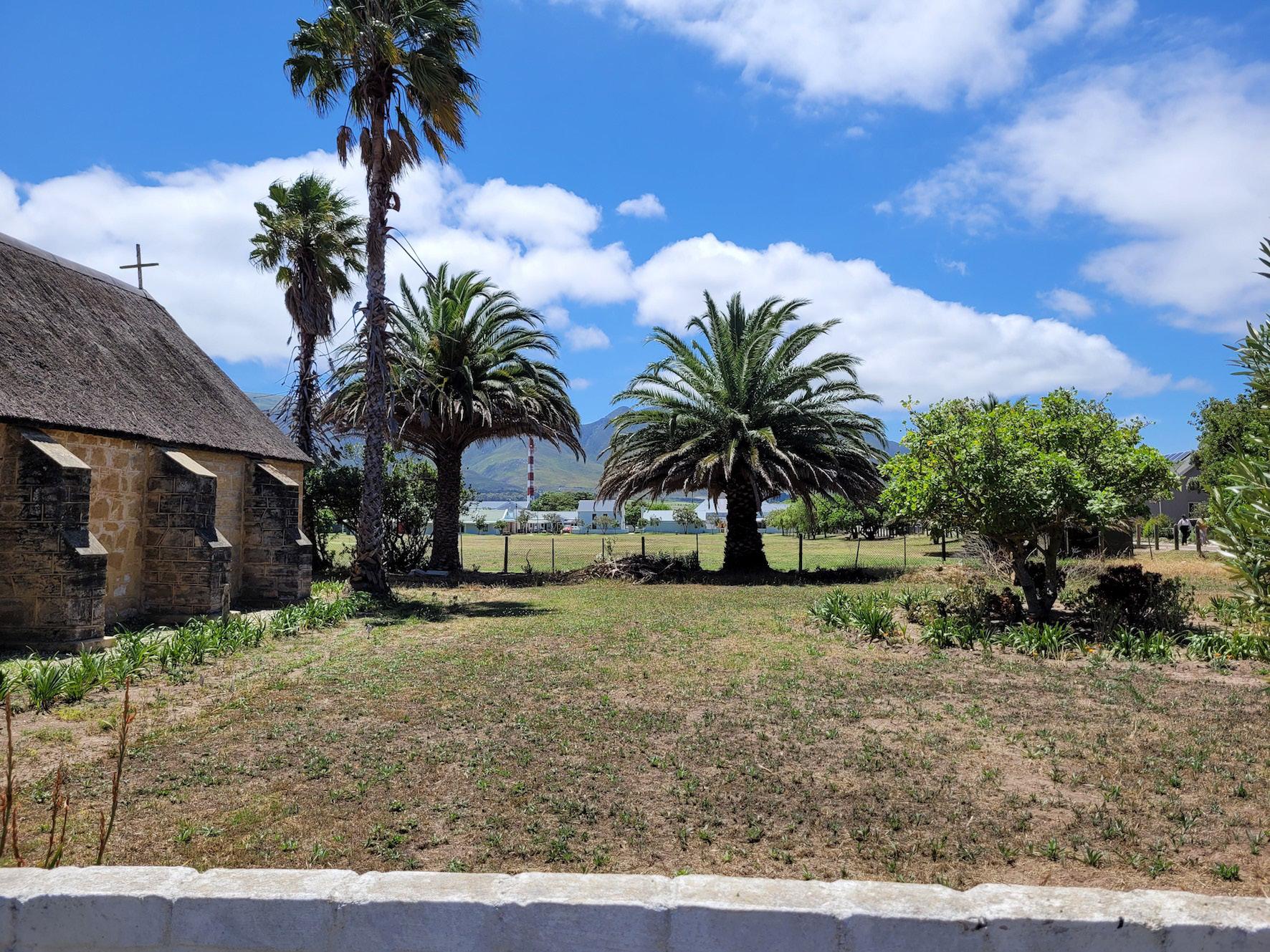
While some work was done to clean up the garden, a stroll along that road and a peep over the wall this month, shows that the little stone brick Church, so much part of Stanford’s rich history and a heritage gem, is crying out for help.
One of the issues, it seems, is that the restoration of the Church, one of the oldest in the area, is a matter for the church hierarchy to take on board. A high priority, apart from the interior fittings and the garden, is that the thatched roof is beginning to show signs of severe weather damage, and something needs to be done soon to halt any further degradation of this listed building.
Some years ago, the Stanford Conservation Association organised and guided the res toration of St Thomas Anglican Church, with the help of volunteers. The issue now is the church’s ongoing status within the dioceses and the chain of responsibility regarding its preservation and upkeep.
Built around 1880, St Thomas Anglican Church in Morton Street is the oldest church in Stanford. The Moore family carved some of the pews and pulpit, and the material for the thatch roof came from the surrounding area. In 1892, The Bishop of Cape Town gave permission for weddings to be performed in the chapel.
Top left: Stanford’s oldest church and its garden (below) need attention.
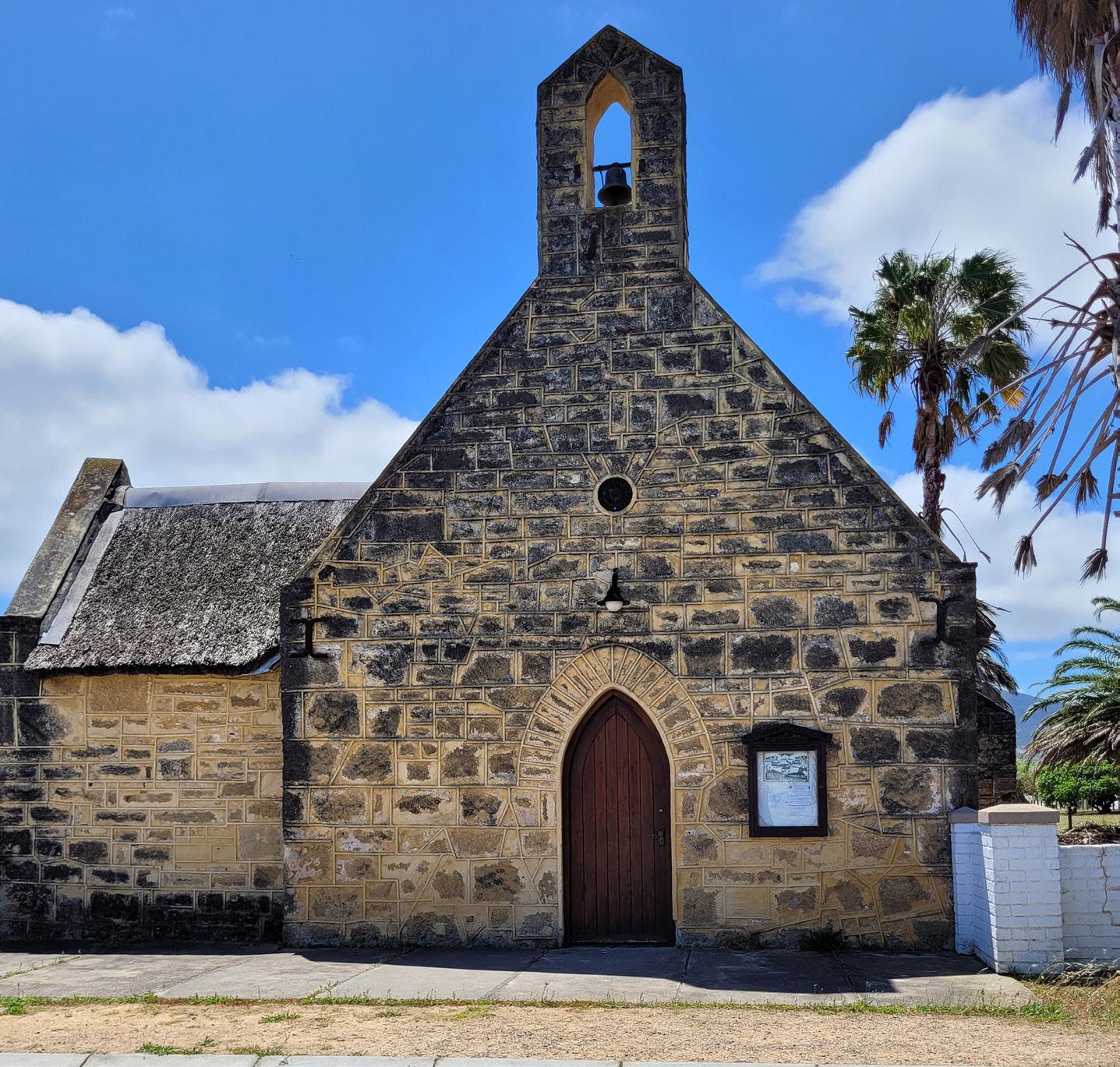
In much the same vein, a group of history-loving residents, many of them newcomers to Stanford, are keen to assist in the upgrading and care of Stanford’s two oldest cemeteries in Moore Street, which are currently in need of a clean-up, both the area and the graves themselves.
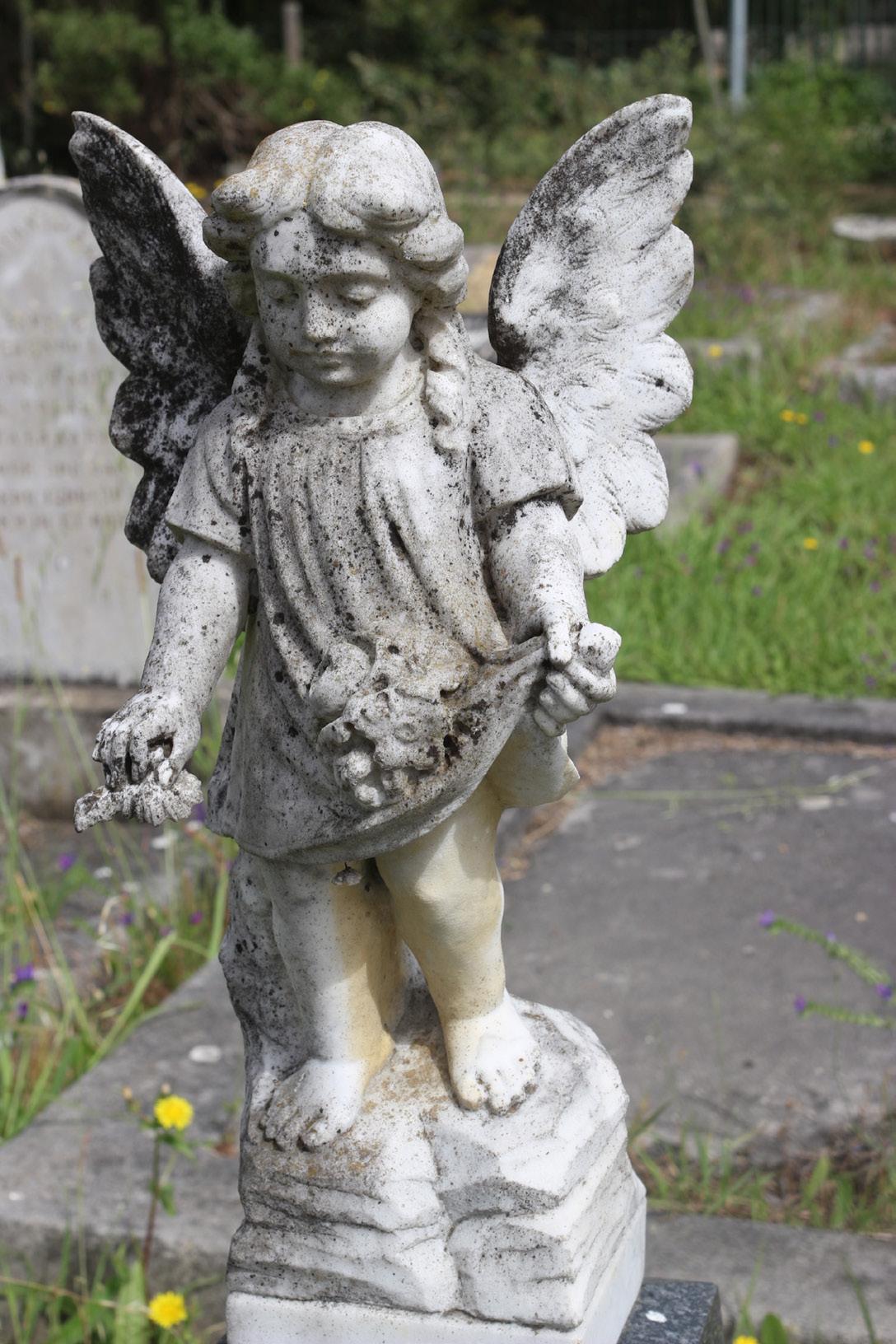
A preliminary walk around of the two cemeteries shows that many of the graves date back more than 150 years and that many of those
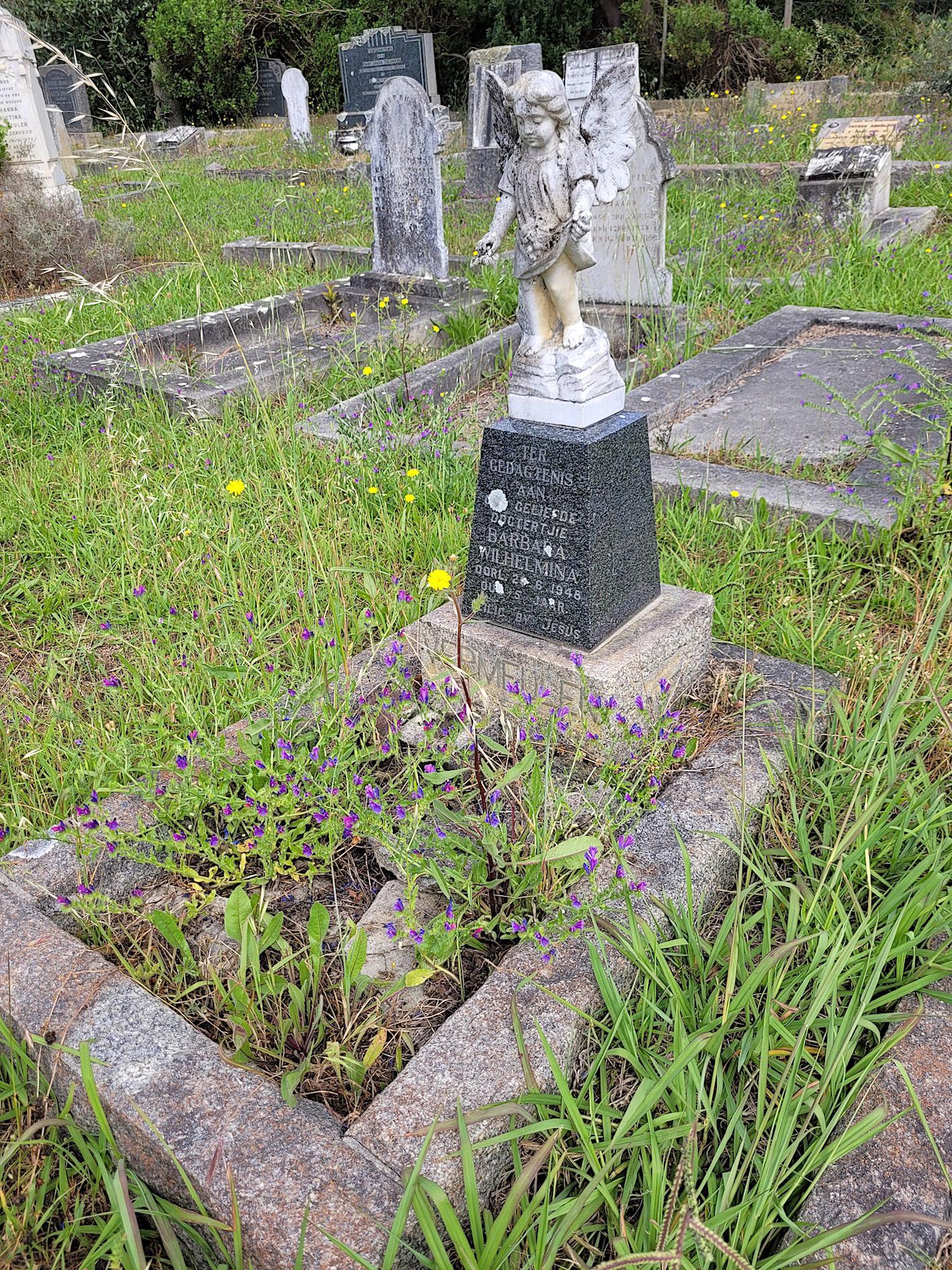
buried there are children under five years of age.
The group has called their project ‘The Forgotten Ones’ and are en listing the help of volunteers to restore these resting places and even make them places of interest to visit.
At a later stage, it is hoped that an information pamphlet with some historical notes can be created to broaden the awareness of legacy and heritage in Stanford.
Cape Nature tells us that the western Cape has the highest diversity of wild irises (part of the Iridaceae family) in the world, many of them occurring right here in the gar dens and foothills of Stanford.
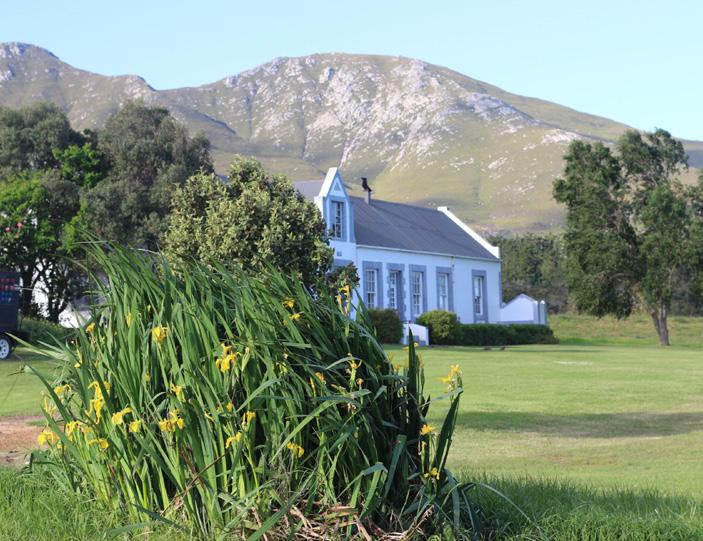
The Iridaceae includes 33 genera that are native to southern Africa with some spectac ular and showy blooms. It includes Watsonia, Gladiolus, Ixia, Freesia, and Dietes.
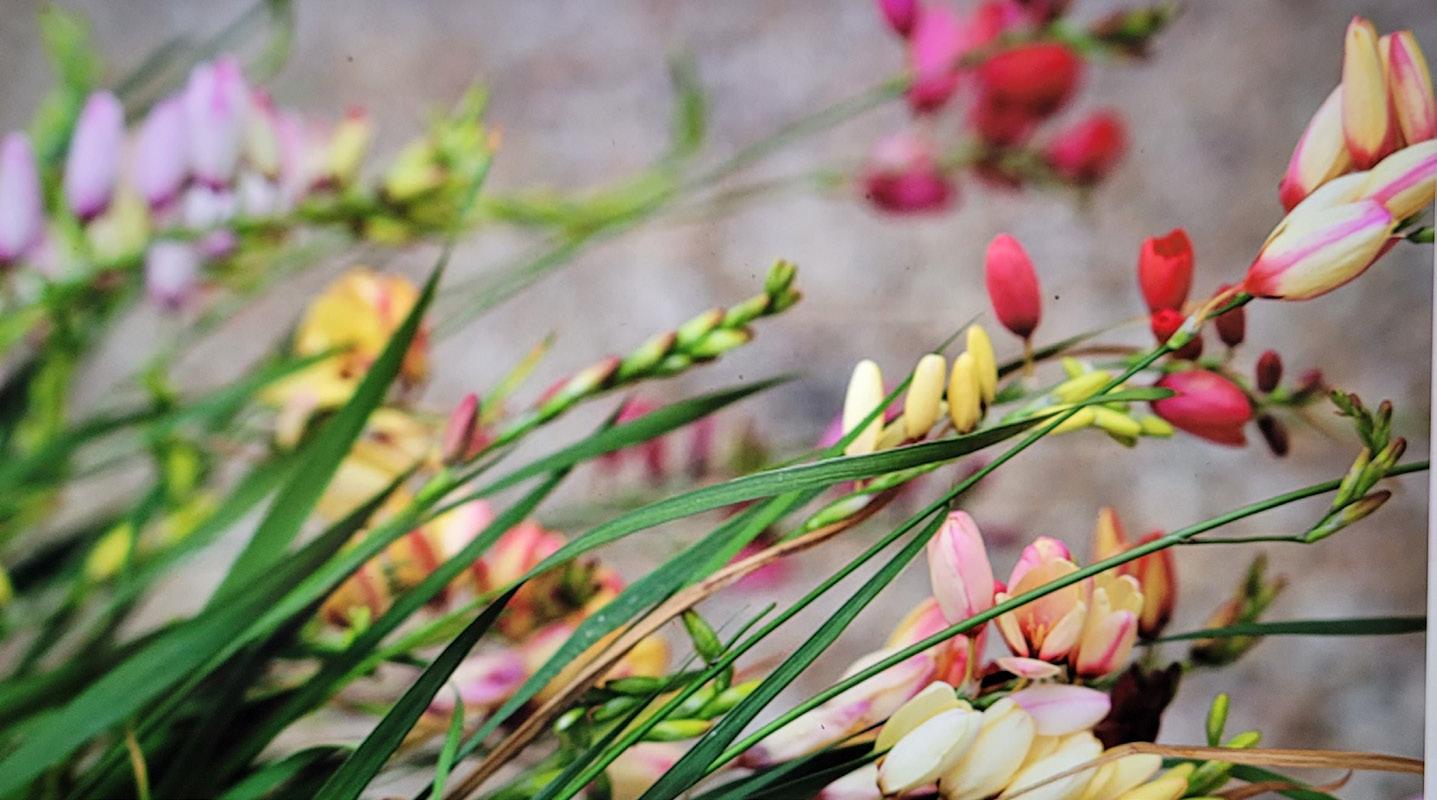
Dietes grandiflora has white, iris-like flowers and unique yellow and mauve markings. If you take a walk around the Zesty Lemon, Butterfly Centre, or further up to Stanford Hills, you will find one of the best displays ever.
The ancients tells that when the wild Dietes bloom, rain will follow; a message hugely useful to those who are close to the land, and was used as a sign from the gods as the time for planting.
Each bloom has a nectar guide that attracts pollinators such as butterflies and humming birds, which is why the Iridaceae wild species you see around us are so critical to the bio sphere – and of course, why we treasure them so much.
The hills are alive with wild irises and co lourful Ixia – also part of the iris family.
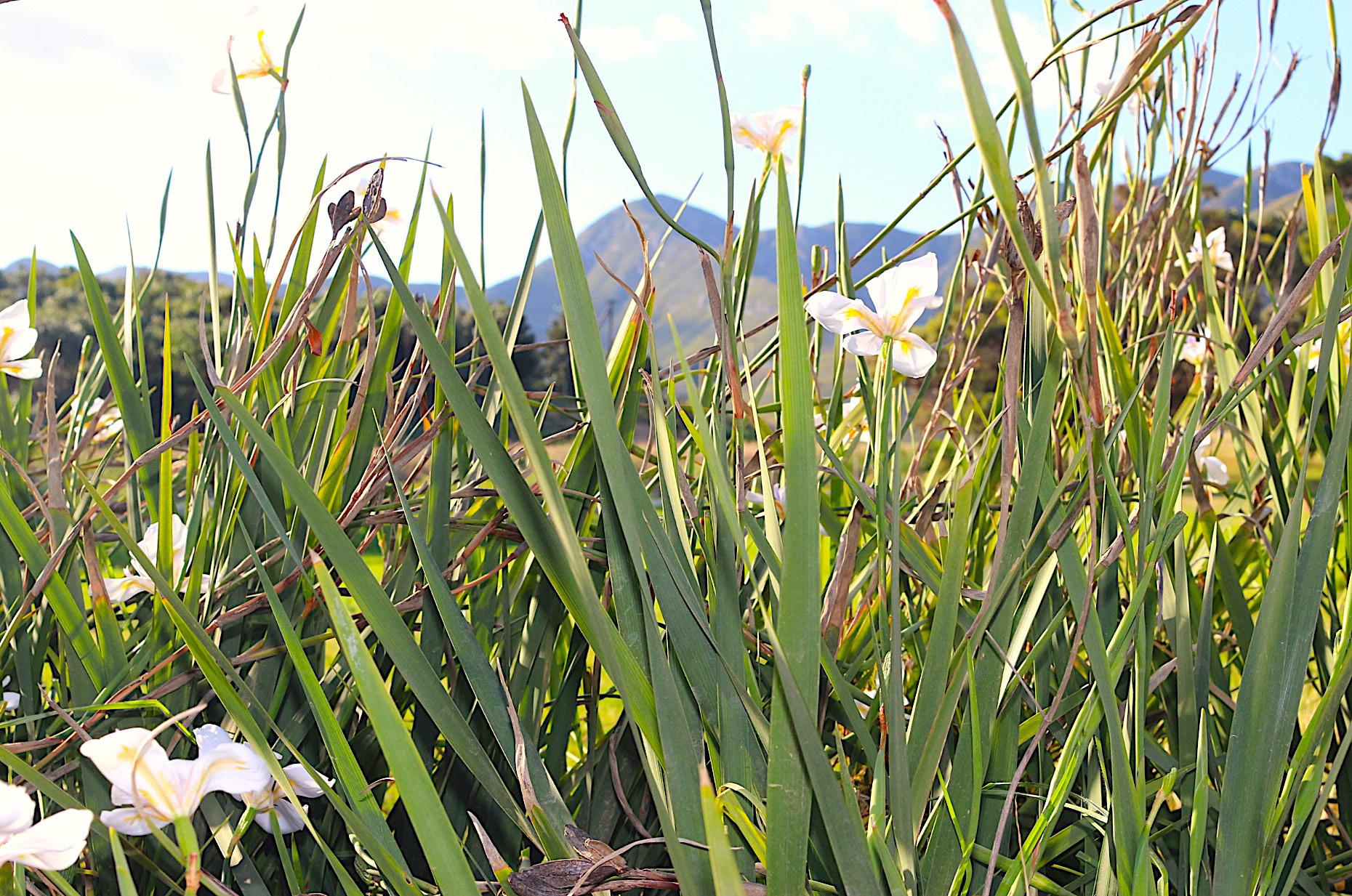
According to the Victorian language of flowers, the colour of the iris has different meanings. White irises symbolised purity, yellow irises passion, blue irises faith and hope, and purple irises royalty and wisdom. A floral favourite, many an artist has been inspired by the iris’s uniqueness and beauty.
For the Stanford Bird Club, November is Tern Month with these summer visitors starting to arrive on South African shores in huge numbers. But identifying Terns is tough, and it’s only with practice, patience and experience that one can start to tell these remarkable seabirds apart.
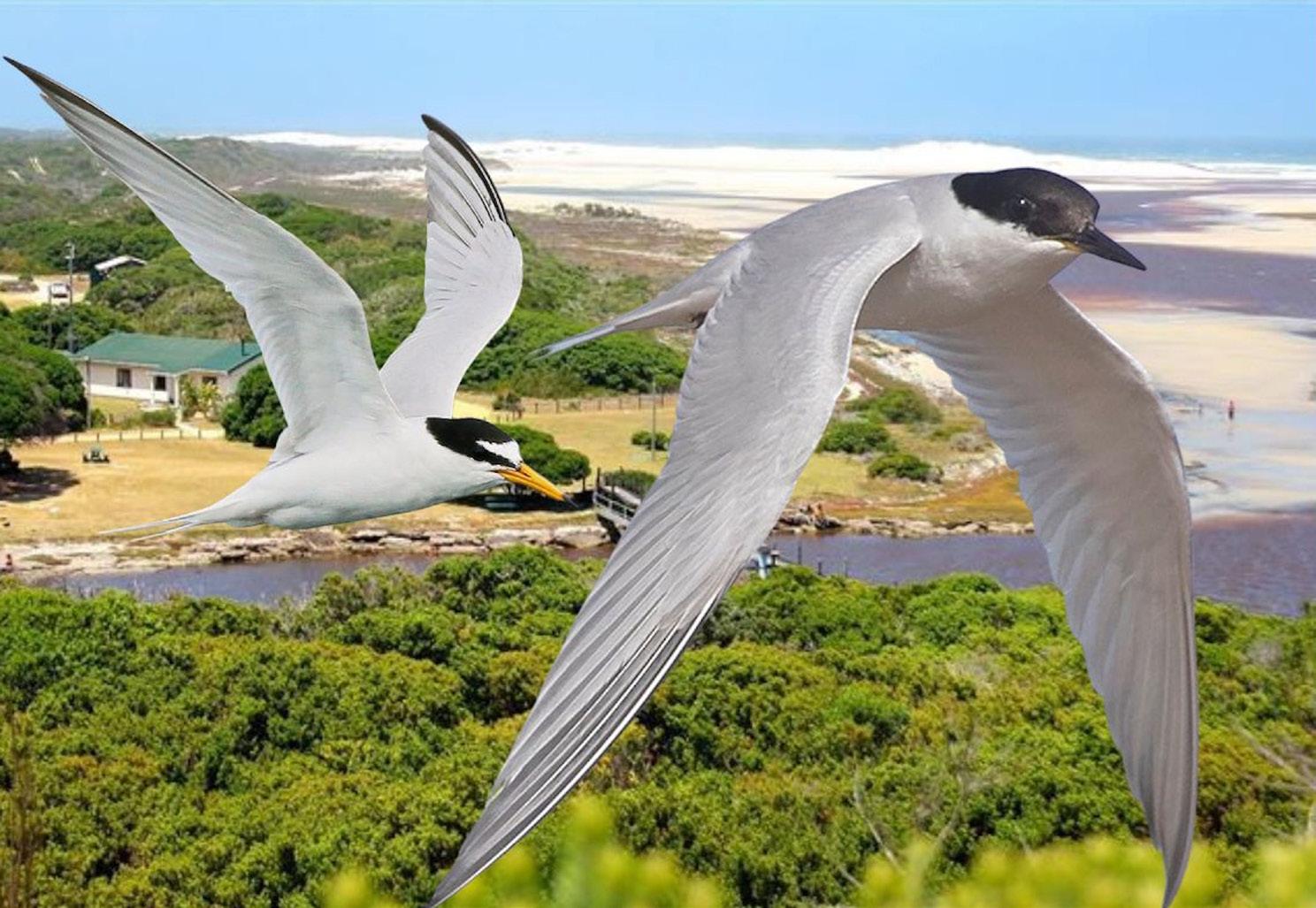
No book or app can provide what personal field experience can do, and heading out to De Mond Nature Reserve, as we did a couple of weeks ago, provided an ideal opportunity to find our targets of Little and Damara Tern. As my bird book points out differences between these two smallest species right off the bat, you know you’re in for a challenge. Reliable patterns and consistent differences are only visible if the bird presents itself sitting perfectly still, and the chances of that are, well, little.

As Terns often occur in mixed flocks or roosts, it is not a bird outing one attempts without an experi enced guide and here, we’re lucky. Among the club’s members are some seasoned birders who are keen to share their knowledge and help make identifica tion of tricky birds a little easier.
But by far the best experience of Terns is witness ing them suddenly swoop off the ground en masse and swirling above your head in a cloud of wings. Called a Cotillion of Terns, it must be one of the love liest collective nouns for a group of creatures.
The beautiful coastal nature reserve of De Mond offers a lot more than Terns - we note every bird en route too, with more than 150 species counted on our last visit. A sanctuary for marine life and seabirds, it is also a World Heritage Site which lies at the mouth of the Heuningnes River, 26km southeast of Bredasdorp.
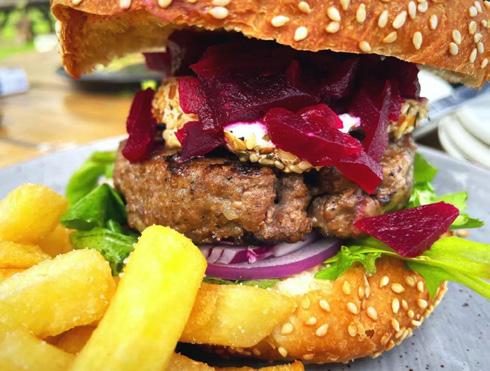
Our menu has been updated and has some thing to cater for every taste. The extensive breakfast menu includes some exceptional items, like our Rosti Royale, for instance, which has become a firm favourite. It’s a potato rosti topped with smoked salmon, a poached egg, capers, all topped off with basil crème fraiche.
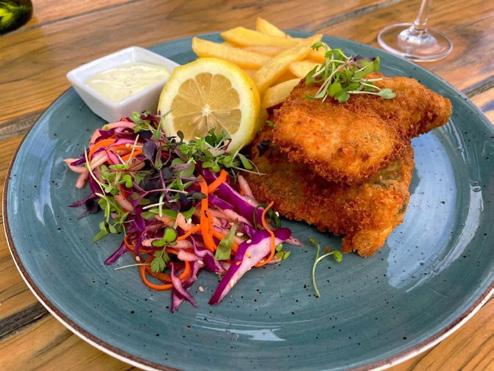
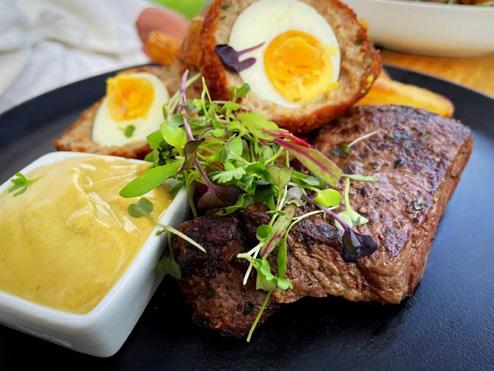
Our wood fired pizza oven has been a great addition, because after all, who doesn’t love a great pizza?! Our new kiddies lunch boxes have also proved a hit; a handy lunch box containing a choice of a cheeseburger, fish bites or chicken strips. Added to this is a fizzer, lollipop, juice and fries – all of this for only R85! Kids at Stanford Hills love being able to enjoy their lunch wherever they choose, which usually ends up being on the pirate ship.
A new initiative is our ‘Pensioners Tuesdays’ – a pensioners card gets you 10% discount on your bill at the Tasting Room. And, as always, furry friends are welcome too. The last Monday of every month sees the local walking group, ‘The Stanford Striders’, meeting up at the farm. A meander around the vineyards and flowers is followed by a delicious meal (usually a lasagne or Melan zane Parmagiano and salad), AND a glass
of wine for the special Striders price. Our reception and wine shop area has also seen some recent upgrades. We still sell our full selection of Stanford Hills estate wines at cellar door prices, as well as fresh bunches of proteas, pincushions, and fynbos. Special bouquets can be made up upon request. We have a wonderful selection of gift ideas, including our very popular leggings, so do keep us in mind when doing your Christmas shopping. Wine tasting is a great activity for your friends and family looking for some thing to do this coming festive season, and R70 allows you to try seven different wines and learn a lot in the process.
Sam’s garden of remembrance is looking beautiful and is open for members of the public to wander around, and to leave a stone in honour of a loved one lost. At the top of the garden is a path leading to a very special labyrinth. Labyrinth walking is an an cient practice used by many different faiths for spiritual centering, contemplation, and prayer. Entering the path of a labyrinth, you walk slowly while quieting your mind and focusing on a spiritual question or prayer.
Finally, our stage area is currently under ren ovation as we have a roof going up to protect
our performing artists from the elements. It’s nearing that time once again when we have our Summer Sessions at the Stanford Hills farm with a great line up of talent:
• 18 December: Springbok Nude Girls, Albert Frost and Black Cat Bones
• 21 December: GoodLuck, Will Linley, Casey Lowry and Veranda Panda
• 23 December: Jeremy Loops
• 27 December: Sunset Sweatshop
Be sure to like and follow our social media pages to be kept up to date on all the infor mation and details pertaining to happenings and events, as well as for when our ticket sales go live.
We look forward to a great season ahead. Thank you all for the support, and we can’t wait to welcome you in the months to come!
With much love from Jami, Peter and the Stanford Hills team.
www.stanfordhills.co.za Tel: +27 (0)28 341 0841 www.facebook.com/stanfordhillsestate
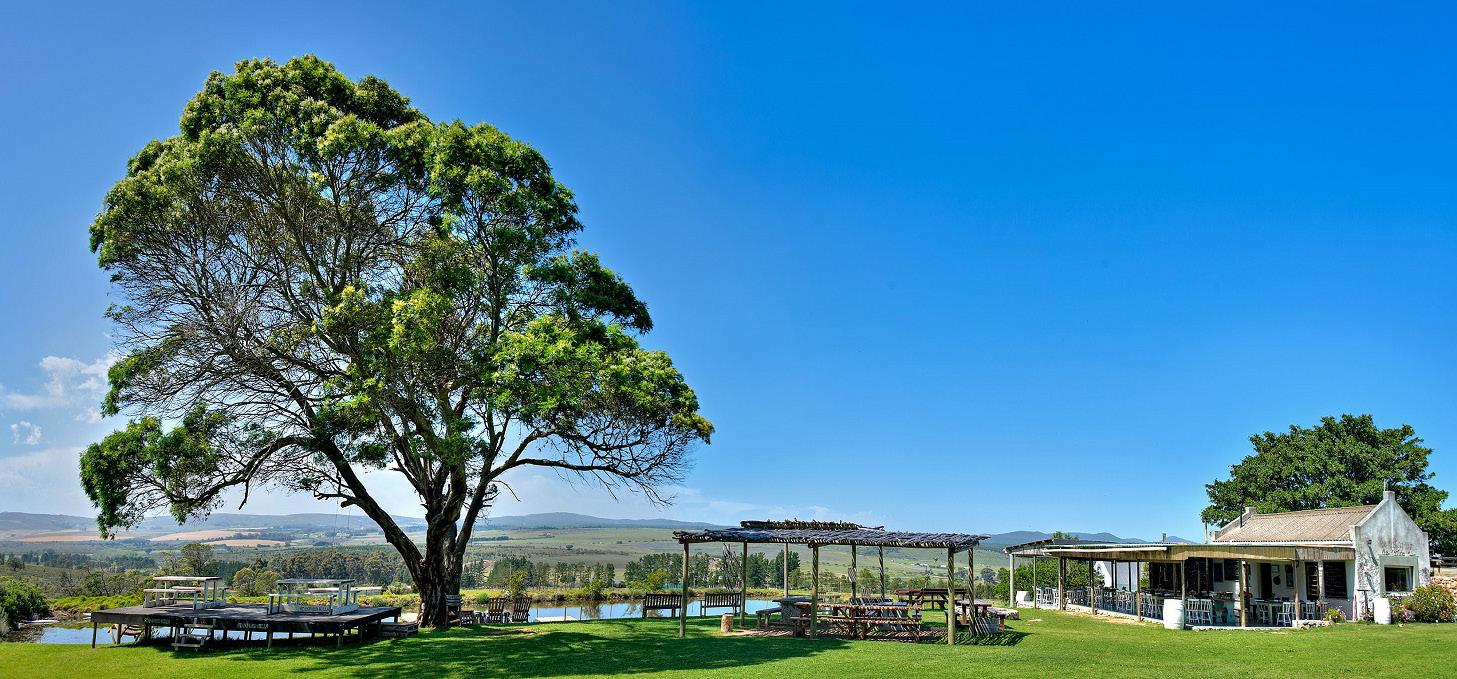
Our oceans are in trouble, deep trouble. We need to think of ways to nurture what goes on beneath the waves, the bits that we don’t see, the watery landscape that is crying out for help!
Returning the shells of oysters, mussels, and our own legally harvested abalone to the seabed is seen as one of the answers, say in ternational ocean researchers identifying reefs and potential reef areas that are in trouble and need rehabilitation, like many of our own.
It can be done, they say, in a variety of forms and the big advantage is that the recycled shells, currently chucked into landfill sites, could be reconstructed into reef “balls” to help new life evolve.
On the eve of the Conference of the Parties (COP27) in Egypt, Ecotourism Writer Sharon McDonnell, a travel writer enthusiastic about sustainable living and ecotourism, has made this call for action.
“Think of all the oyster and seafood shells –left-overs from restaurants, seafood bars and the like - that are discarded into our landfill sites around the world, millions of them! We need to save them. Do something good with them.”
You only have to note the number of local seafood eateries in the Overstrand to see there’s
no shortage of empty seafood shells in this part of the world. McDonnell has done some pretty thorough shell research on a global scale.
“It took just under 100 years for New York ers to wipe out the wild oyster population in New York harbour” she says. “Now the Billion Oyster Project is rebuilding that natural re source and habitat, with the help of students, volunteers and partners.”
A conservancy project in Australia, says Mc Donnell, involves the collection of used oyster, mussel and scallop shells from restaurants, venues and seafood wholesalers in areas near to where reefs exist. The shells are cured to kill off any diseases by laying them out in the sun for a few months after which they are bagged and later spread over limestone rubble for the young shellfish to latch on to.
“Going forward 7,000m3 of shell waste will be diverted from landfill, to be recycled into new reefs” writes McDonnell. “And that’s one heck of a lot of shells that would have other wise gone to waste!”
True, much of the seafood we eat is espe cially “farmed” but what about the shells? May be it’s time we consider all the “good” things we are throwing away. Maybe it’s time we give back to the sea.
• Reef balls (cement mixed with oyster or other shells) and fibreglass panels are being used to encourage new life in many of the denuded shellfish beds. So too are wire cages filled with seafood shells that are lowered into the ocean.
• Shellfish feed on phytoplankton but can also accumulate marine bio toxins; chemical contaminants; and pathogenic microorganisms, such as bacteria and viruses; effectively re moving them from the water column.
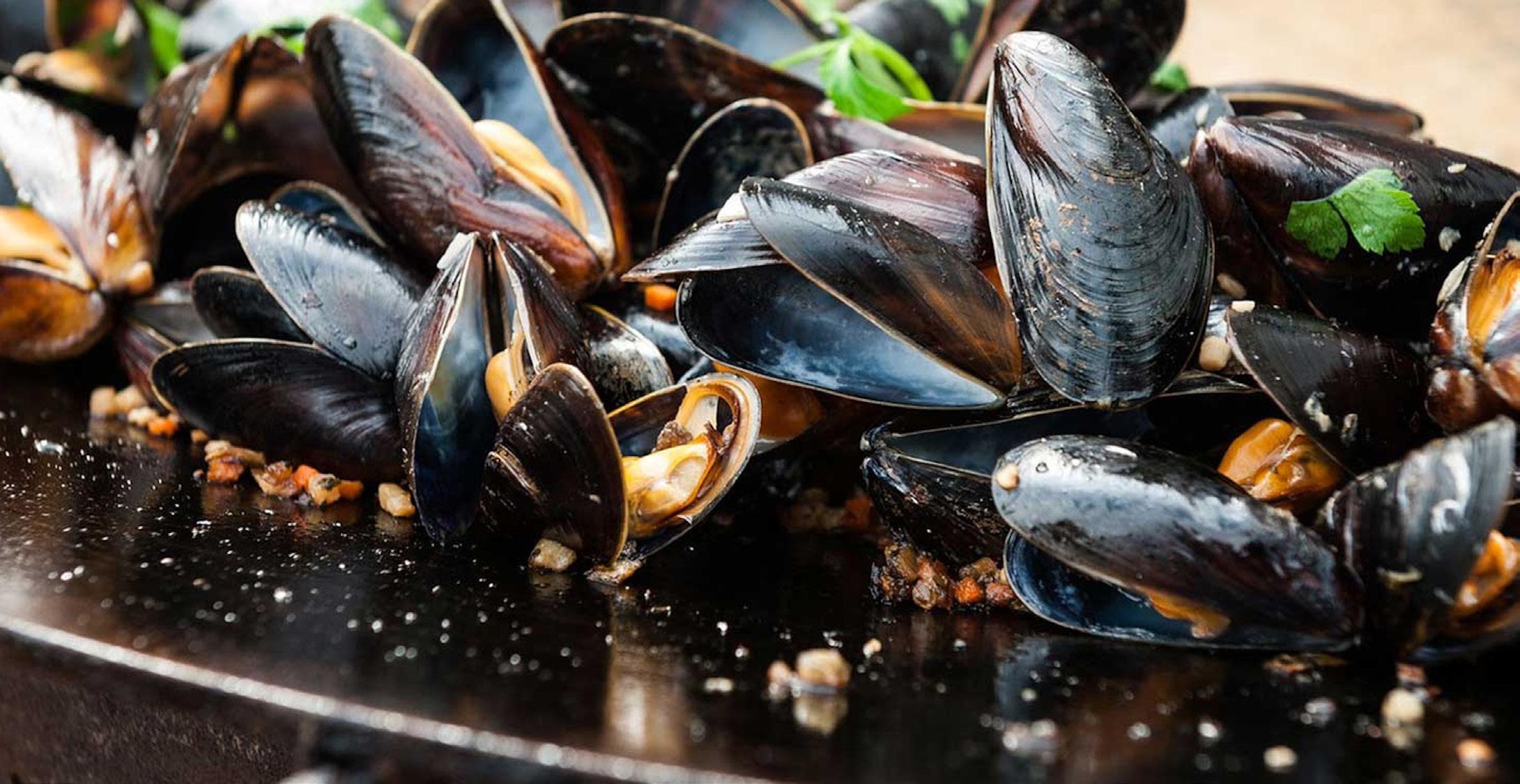
• Shellfish help control harmful blooms, such as red tide, by remov ing algal cells before they accumulate to harmful levels.
• Improved water quality makes the environment more suitable for veg etation and organisms that require high water clarity, such as eelgrass.
• The nooks and crannies of shellfish beds create structure and habitat for invertebrates and juvenile fish, which are a food source for predatory fish and other marine species. Healthy shellfish populations help to support finfish populations.
This page is sponsored by Seeff Stanford.

“A perfect summer day is when the sun is shining, the breeze is blowing, the birds are singing, and the lawnmower is broken.” — James Dent
Summer is in full bloom, as flowers display their beautiful variety of bright colour combinations and sweet aromas. Who needs an excuse to spend quality time outdoors to appreciate garden splen dour?! It’s also Hydrangeas favourite time to bloom with their gorgeous mauves, blues, pinks, lilacs and whites. Popularity is growing for container gardens as they are a convenient and water-wise way to grow flowers and vegetables. Flowers truly are the perfect gift for any event or occasion.
Celebrating the festive season comes with gift giving, so here are a few garden gift ideas to consider:
• For those who love to be in the kitchen, herb jars with herbs grown from seeds are a fantastic gift to give.
• Utilise the fresh veg and herbs from your own garden to make jars of pick les, relishes or fresh pasta sauces.
• Spoil your loved ones by making a body scrub with sea salt mixed with an aromatic oil of choice and add some lavender flowers and rose petals to the mix.
• Lavender bags made with the flowers and leaves make perfect fresheners for cupboards and drawers.
• Make dried potpourri with rose petals, lavender and other aromatic flowers to keep a room smelling floral and fresh.
Enjoy your garden this festive season!
KEY:
Full sun
Full Sun / Semi Shade Shade Semi Shade Shade / Semi Shade
Some top tips to keep your garden in tip-top shape this month:
HERBS TO PLANT: Basil Coriander Chives Chamomile Echiacea Lavender Oregano Parsley Rocket Thyme Watercress
• Prune fynbos flowers buchus, leucospermums, ericas and proteas, and add mulch.
• Water summer-flowering bulbs twice a week and feed once a month.
• Plant hydrangeas in beds or containers.
• Look out for the lily borer (a black caterpillar with yellow stripes) on lily-like plants such as Clivia, Agapanthus, Arums and Hemerocallis, and treat accordingly.
• Water, fertilise and deadhead roses.
• Mow lawns weekly and feed once a month.
• Remember to be water-wise!

VEGGIES TO PLANT:
Beans Beetroot Broccoli Cabbage Carrots Cauliflowers Celery Cucumbers Eggplants Lettuce Maize Okra Peppers Pumpkins Radish Squash Sweetcorn Sweetmelons Swisschard Tomatoes Turnips Watermelons
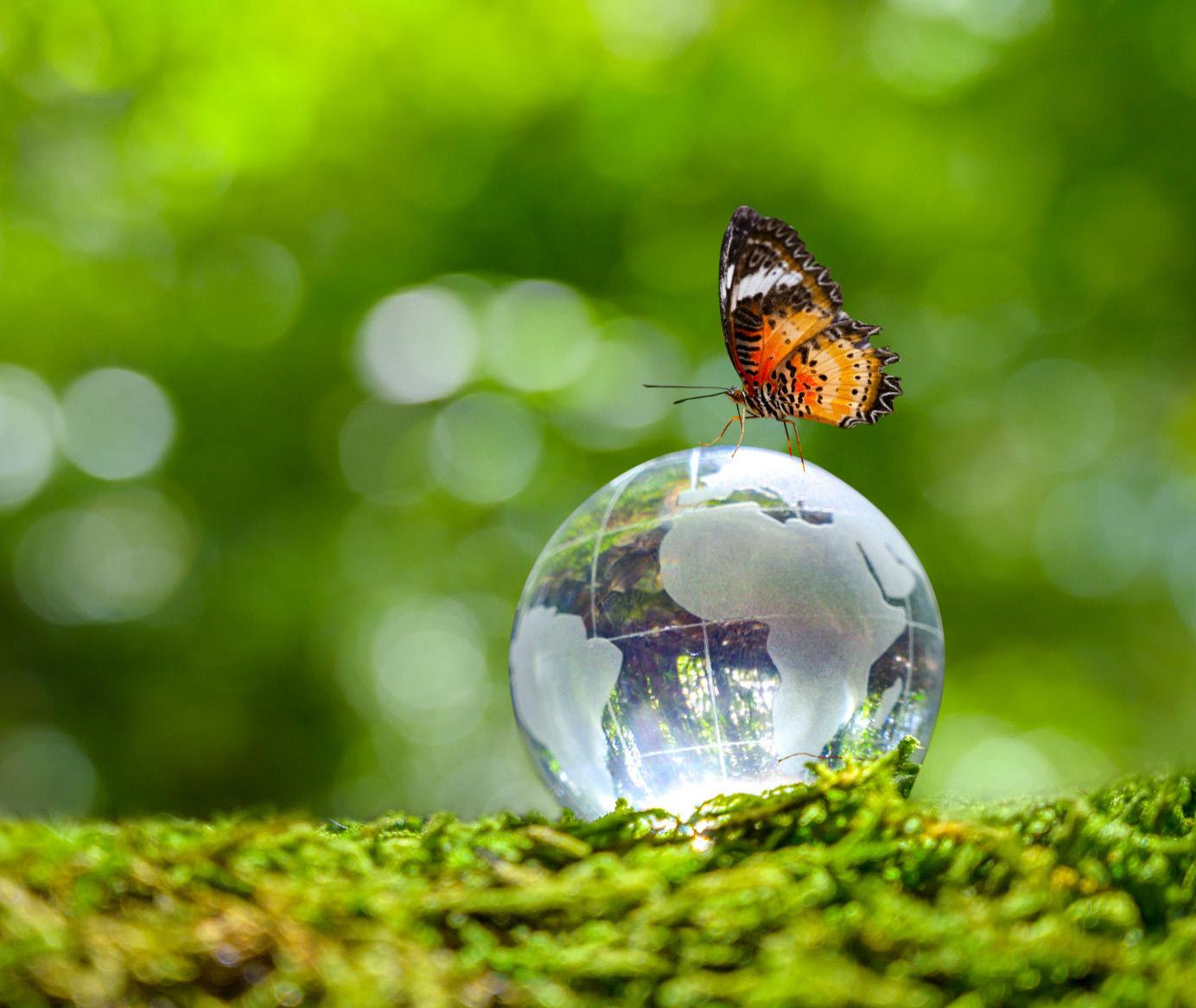 Writer: Heather Robertson (Daily Maverick)
Writer: Heather Robertson (Daily Maverick)
Reporting from COP27 in Egypt, Ethan van Diemen has talked to global experts who care deeply about the fate of our planet. Most of them have told him how they are blown away by the work South Africa has done in its ‘Just Energy Transition’ (JET) plan ning.
Now I know, as we battle the umpteenth bout of staring into the abyss of our living rooms, singing “hello darkness my old friend”, and we hear about another round of the morbid symptoms of our political idiocracy, it’s hard to believe that South Africa can be any good at anything at all.
But, according to Ethan’s extensive interviews, our JET team not only devised a plan to reduce our carbon emissions and through it potentially save us from floods, droughts and rising sea levels but, crucially, also had deep consultations with the communities, workers and miners who would be most affected by a transition away from coal. It seems too good to be true but, dear readers, South Africa actually does have a plan that puts people and the planet first.
I know you might ask why you should care and what’s the catch? President Cyril Ramaphosa and the JET plan have attracted billions in investments for the transition, amounts that could just as well be Monopoly money for a population struggling to make a monthly salary stretch to the next payday (if they are fortunate enough to have a salary or wage at all).
And then there’s that little factoid about who’s actually governing, or rather misgoverning, our country. If they stay in charge, won’t the investments meant to clean up our energy act go the way all money goes in South Africa, down the gullets of ANC gluttons?

Journalists are not sangomas (not all of us anyway), but we can read between the lines, join the dots and make some educated guesses based on the many experts, deep throats, leaders, reports, plans and documents to which we have access. We will keep on following the money and expose any corruption in this plan if we unearth it.
We should not let our pilfering governing party distract us from the fact that the climate crisis is real. And that the JET plan on paper is a global first in its effort to deal with the crisis.
Heather
Yours in defence of truth and our planet.
